- Home
-
SHOP ECO FARM
- ECO Farm Grow Lights
- ECO Farm LED Grow Lights
- ECO Farm Quantum Board
- ECO Farm Samsung LED Grow Lights
- ECO Farm COB Grow Lights
- ECO Farm Commercial Lights
- ECO Farm Supplemental Grow Light
- ECO Farm Fluorescent grow lights
- ECO Farm HPS & MH Grow Lights
- ECO Farm CMH Grow Lights
- ECO Farm HID/CMH Bulbs & Ballasts
- ECO Farm Grow Tents & Kits
- ECO Farm 2x2ft Grow Kits
- ECO Farm 3x3ft Grow Kits
- ECO Farm 3.3x3.3ft Grow Kits
- ECO Farm 4x4ft Grow Kits
- ECO Farm 5x5ft Grow Kits
- ECO Farm Grow Tent - Standard Style
- ECO Farm Grow Tent - Extension & Roof & Lodge Style
- ECO Farm Extraction & Harvest
- ECO Farm Rosin Press Machine
- ECO Farm Dry & Wet Trimmers
- ECO Farm Oil Accessories
- ECO Farm Medicinal Plants Grinder
- ECO Farm Medicinal Plants Containers
- ECO Farm Medicinal Plants Dryer
- ECO Farm Refrigeration Dryer
- ECO Farm Climate Control & Other Accessories
- ECO Farm Inline Duct Fans
- ECO Farm Oscillating Fans
- ECO Farm Exhaust Fans
- ECO Farm Air Filter
- ECO Farm Duct Muffler
- ECO Farm Ventilation Kits
- ECO Farm Plant Humidifiers
- ECO Farm Plant Dehumidifiers
- ECO Farm Hydroponic Accessories
- ECO Farm Other Accessories
- ECO Farm Hydroponics Microscopes
-
TOP BRANDS
- Grow Lights Brands
- Adjust-A-Wing
- Apollo Horticulture
- Bestva
- Black Dog LED
- California Lightworks
- ChilLED Grow Light
- Eco Farm
- HLG - Horticulture Lighting Group
- Kingled
- Kind LED
- Mars Hydro
- Morsen
- Neilo
- NextLight
- Phlizon
- PlatinumLed
- Roleadro
- Optic LED Grow Lights
- ViparSpectra
- Vivosun
- EYE Hortilux
- IPOWER
- NanoLux
- Phantom grow light
- Gavita grow lights
- Grower's Choice
- Lumatek
- Maxibright
- Yearld Pro
- ThinkGrow
- Crecer Lighting
- Green Sunshine Electric Sky
- fohse aries
- loriflux
- luxx
- fluence
- iluminar
- Lex
- LTC
- Rayonled
- FGI
- PHOTONTEK
- Grow Tents & Kits Brands
- Apollo Horticulture
- Black Box
- CoolGrows
- Eco Farm
- GrowLab
- Gorilla Grow Tents
- Mars Hydro
- Quictent
- Secret Jardin
- Unit Farm
- TopoGrow
- VIVOSUN
- Topolite
-
COMPANY INFO
-
COOPERATE WITH US
- Blog
ECO Farm Mini Flexible Electric Clip Fan VS Active Air 6" Clip On Fan
August 11, 2021
As an indoor grower, one thing that should never escape your mind is the ventilation of the grow room. Many indoor growers fail to recognize the importance of proper ventilation to their crops, and this leads to poor returns from their hard work.
Whether you are using grow tents, cabinet rooms, or any other form of grow-room, keeping a stable environment is the surest way of getting good returns.
Why Do You Need to Use Indoor Grow Fans?
Plants absorb all of the Co2 available around them within around one minute, which is why you’ll need to set up the inline fans near your plants; they distribute any new air around the grow room so that all of your plants have access to a constant stream of Co2 and so that your plants aren’t affected by stagnant air, which can cause illnesses and humidity.
With just a little extra airflow, your plants will be able to breathe much better, improving photosynthesis, nutrient absorption and generally increasing your plants’ strength; the branches will grow stronger thanks to the slight wind resistance, which means that during the flowering period they’ll be able to grow thicker, heftier flowers.
At the same time expelling the air inside will keep temperature and moisture build-up under control, preventing mold and mildew from forming on your plant’s leaves, inhibiting growth.
Refreshing the air inside has the added benefit of removing strong odors.
ECO Farm Mini Flexible Electric Clip Fan
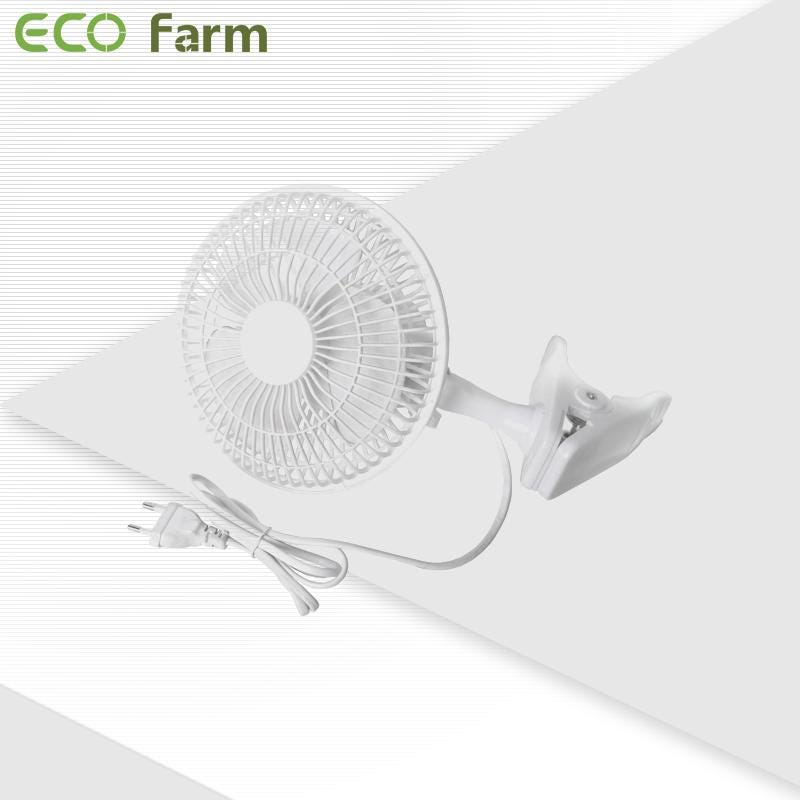
Features:
The ECO Farm fan is made from sturdy materials. You can simply adjust the direction of the airflow by the use of a shake rod. You can mount this grow tent Oscillating fan on the wall or put it on a stand in a tent. This fan is versatile and convenient by ensuring a thorough circulation of the air within the room. It favors indoor gardening. With indoor grow operations you don’t need to move around hundreds of cubic feet of air (let the exhaust fans do that). It features two speeds settings. You can conveniently select the right speed to support plant growth. Unlike most swing fans, this fan product is well made to prioritize quality. The parts are ingeniously manufactured to provide durable products. It also runs quietly, spreading air in your planting tent, keeping it quiet and cool. It also allows you to achieve good coverage. Lightweight fan size can be installed well in small tents.
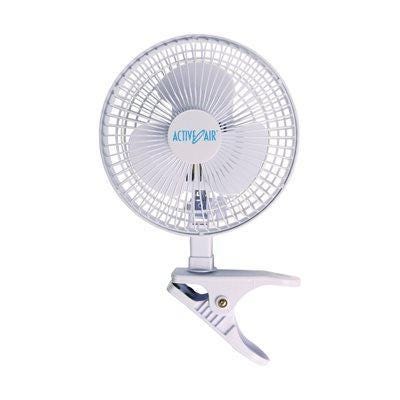
Features:
The space-saving design of the Active Air 6-inch Clip-On Fan is great for basically anywhere space is limited and air circulation is desired. The spring-loaded plastic clip won’t mar surfaces and the adjustable head directs air flow where you need it with its 360-degree flexibility. The fan features plastic blades and the easily removable safety grill makes it easy to clean it when necessary. Active Air has a high quality magnetic brushless motor for longer life and energy efficiencies. This 6-inch fan has a quiet operation, so it won’t bother you or those around you, and it might just save you on energy costs since you can direct air circulation right where you want it instead of cooling a much larger space. This fan also can be mounted on a wall.
Consider These Factors Before You Purchase Your Fan
The Materials of the Fan
Materials used in building the best oscillating fans are crucial in determining their durability. With the difference in materials used by different manufacturers in making fans, it is important to check on the oscillating fans created with the most durable materials.
Fans with variable speed settings are best in effectively controlling the airflow in the grow room. These fans for grow tents give you an allowance to customize your fan to meet the needs of your grow room.
Most oscillating fans contain low, medium, and high settings. You can go for those with a control knob or pull chain control.
Grow Tent Size
If you have a bigger grow tent, you would consider getting a fan that will match your needs. Don’t mistake the size of your grow tent with the size of the fan.
What matters is the strength of a fan. If you have such a big grow tent, you may consider going for a powerful oscillating fan to circulate the air.
Fan Noise
In most cases, the most powerful oscillating fans for grow tents tend to have the loudest noise. If you don’t like noisy fans, you may consider getting several fans in your grow tent. Since you know your fan’s purpose, it will be wise to make the right decision according to your grow tent needs in circulating air.
Price of The Fan
The best oscillating fans for grow tents overall will always cost more. But you can get your favorite fan to do your job within the category of your money. Always lookout for the most rewarding features when you don’t have all the cash to get the most expensive fan.
Oscillating Angles
One may find it rewarding if you go for an adjustable tilt fan. Some have an adjustable tilt from 90 degrees to 360 degrees. This can help maximize the movement of active air in every direction of your grow tent.
You could also be interested in directing active air in one particular direction; the adjustable tilt feature is great at helping you achieve your goal for growing.
Installation
The installation comes down to the specific mounting options by every fan. The common options include standing and wall-mounted.
With these mounting options, one can consider the ease of installing each when it comes to the nature of your grow room.
Fans Take Care of These Issues
Control the Grow Tent’s Temperature and Humidity
Some crops like pot plants & mushrooms will do well under a certain level of temperature and humidity. The same applies when you do mushrooms & plants growing under in a tent.
The ventilation the fan will provide in the grow tent is vital in keeping the temperature and the humidity at desirable levels.
Even Air Circulation
The regular flow of active air throughout the grow tent is essential for the best results. You are interested in getting maximum returns from your grow tent fans.
Crops will take in carbon dioxide and release oxygen during the day and do the opposite at night.
An oscillating fan & adjustable tilt will help move these active air gases around the grow tents to obtain an even distribution of these gases.
This helps you achieve maximum growth potential in a small area with the right product used.
Control Mold and Fungus
A grow tent fan can be an excellent control measure for mold and fungus growth in your tent. In most cases, mildew and fungus grow in a warmer and humid environment.
With a superb regulation of these conditions in the room, mold and fungus will not get a room for growth.
Prevent Pests and Disease In Your Grow Tent
You also need a grow tent oscillating fan to combat pests and diseases. The even distribution of air in the grow tent keeps it ventilated, discouraging the pest attack of your plants.
One thing you want to consider is that most pests like a warmer environment. Keeping your grow tent’s temperature optimal will prevent the pest invasion of your plants.
Conclusion
Having proper ventilation for your grow tent is important if you want to create the best environment for your growing plants. All you need to do is to ensure that you get the right grow tent fan for your grow area.
The right fan will ensure that you reduce the total maintenance cost and your plants will be in a position to thrive and produce higher yields.
Since there are so many grow tent oscillating fans on the market, you need to ensure that you pick the right fan for your grow tent size.
HortiOne 130W LED Grow Light VS Fissioning Samsung LM301B LED Quantum Board Grow Light
August 10, 2021
If you are growing plants indoors then you already know that you will need the best LED grow light in order to get your plants to thrive and give you the best possible harvest at the end. In the last decade, the importance of LED grow lights have grown a lot in the indoor plant growing market. These lights started from being too expensive and less efficient to be in all of the professional growers’ tents and grow rooms all across the world. The LED grow lights have come a long way to become one of the most important aspects of a grow tent or a grow room in order to grow top-quality plants indoors. These new LED grow lights are extremely efficient and they consume much less energy when compared to other traditional plants' indoor grow lights.
The LED grow lights also produce much less heat when compared to HID and MH grow lights. All the professional plant's indoor growers are using LED lights because they cost less money to maintain and they affect the yield in a very positive way.
What are LED Grow Grow Lights?
LED lights are an effective way to grow plants indoors. They are great for growing plants due to the fact that they produce light similar to that of the sun. This makes LED lights one of the most effective systems for growing indoor plants.
To get into the details, LED is short for “light-emitting diode,” meaning that as current flows through the system, the light will be emitted. Furthermore, it produced wavelengths of light that directly enhance the growth rate of your plants.
Why Should I purchase LED Lights?
There are a number of reasons that you should consider purchasing an LED light system.
As mentioned earlier, LED lights are possibly the most effective source of light to grow your indoor plants.
LED lights tend to be extremely durable as compared to other light systems, specifically they are typically both water-proof and dust-proof.
LED lights are a sustainable, eco-friendly energy option.
They have the ability to produce more products, while also enhancing the taste.
LED lighting systems are quite easy to install.
They can reduce your heating and air conditioning costs.
Some LED systems can speed up the growth cycle of the plant.
Difference Between LED and HID
Light-emitting diode or LED lights make use of electricity more efficiently as compared to other technologies like HID bulbs (high-intensity discharge). They will cost you very less even if you run them over time.
A full spectrum of LED panel is a better choice in the case of growing plants as their light resembles natural sunlight with a cost equal to the fraction cost of glowing HID lamps
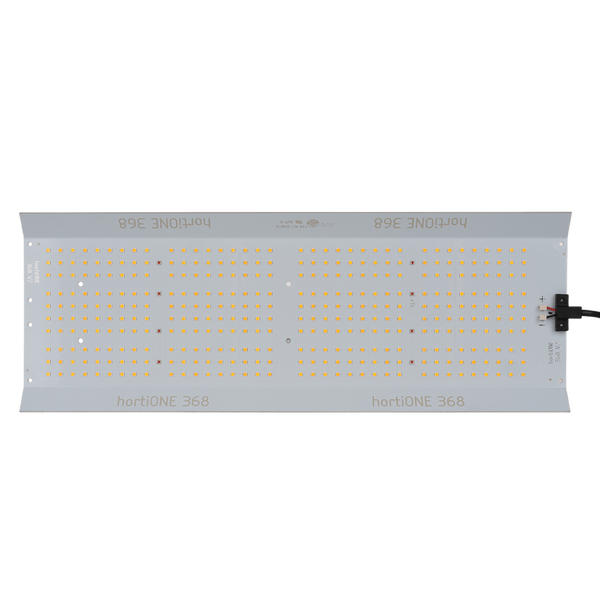
Features;
The new HortiOne LED Grow Light, which has an efficiency of 2,7 µmol! The super bright fixture uses high-quality SEOUL & OSRAM LED Diodes powered by a Meanwell Driver. With a 2 year warranty, the 130w LED Grow Light is dimmable-ready and features a new wire strain relief to take the pressure away from connection points on the LED board mount. The HortiOne LED lamp is a plant light for indoor growth. It is designed to provide a cost-effective, innovative solution for indoor plant growing. The full broadband light spectrum of this fixture makes the HortiOne grow light suitable for all plants at all stages of development, from seeds or cuttings through growth and flowering to fruit or seed production.
Fissioning Samsung LM301B LED Quantum Board Grow Light
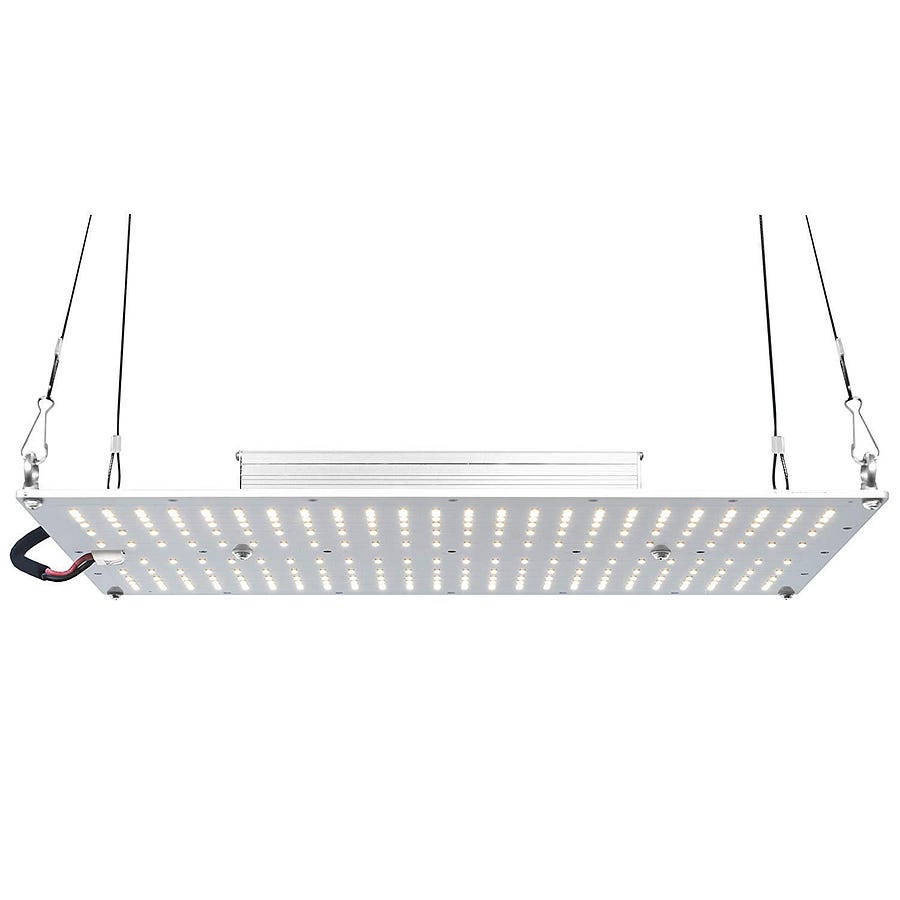
Features:
FISSIONING WAVE 120R supply 2.6 μmol/W and 340 μmol/s PPF, 22000+ lumens and 175 lumens per watt. It is top-level and saves your planting cost and improves the planting efficacy. Special LED layout that supplies well-distributed lights in various hanging heights. Wider coverage and Better light reflection, Design for VEG 3*3ft@24 inch, Flower 2*2ft@12–18 inch. Consists of widely recognized SAMSUNG LM301H(Top BIN), with the full light spectrum that is ideal for plant growth. Power supply by MeanWell HLG-120H-54A is the top series of a top brand, The output voltage and current are adjustable so that you can adjust the light board wattage from 36W-150W for your different needs.
Things To Consider Before Choosing a Grow Light
While buying the best LED grow light, we need to take into consideration the area we want to cover and the intensity of light we require for our purpose. To go into detail there are many aspects that should be taken care of when you buy a plant light. All of them are discussed below:
ACTUAL WATTAGE
It refers to the actual capacity used by the fixtures. The two lights mentioned below have the same wattage whereas the other two have different ranges. This is done so to give you control over the spectrum.
At the time of vegetative age of the plant, plants do not require much light as they need during flowerings. Your electricity cost will be saved if you let your fixture automatically turn off the LEDs.
SPECTRUM:
While analyzing the right spectrum for our LED light, We need to consider 2 factors here.
A. The Color of Light
B. The customization Options in Light
A. The Color of Light: Colored LEDs vs. White LEDs
Fixtures with colored LEDs also have a few white LEDs mixed in them.
A.1) Favour of white light
Proponents of white grow light say that their spectrum is most natural as it is similar to sunlight. Its light is similar to an HPS bulb also when run with a halide metal bulb. Or we can refer to it as an HPS spectrum together with an additional light of blue color.
HPS has proved out to be the best for working with the plants. Also, we know that plants love sunlight, so a white LED is the best option to go for it. Also, it works similar to MH and HPS lights.
Also, there is another advantage of white light i.e. the plants look natural in white light, so it becomes easier to inspect and notice any sort of discolorations in them which is difficult in case of pink lights.
A.2) Against the use of white light
Opponents of this light have pointed out that it is actually made of yellow and green light which is a little used by the plants and generally gets wasted. It is ok in the case of the sun as it is an inexhaustible source of energy and is free of cost too. But in the case of LEDs you are just footing your bill by wasting light.
B. The Customization Options in Light
There are separate modes each for bloom and veg in few lights.
The basic advantage is- lower electricity cost. Plants need more light in flowering and not during vegging. Even during cloning too, there is no requirement of enough lights. So you can dial back the right amount of light as per the user so as to avoid wastage of electricity.
But there is also the flip side to it. If you change the color of lights during mid-growth, plants may get shocked and could suffer from stalling growth for nearly two weeks. The switching modes in LEDs, will not create the problem of stalled growth for long but you should be prepared for a few days to face it.
For that time, you have to pay your electricity bills for running lights and for obtaining nutrients, needed to feed plants. Also, fixtures with one mode are easy to operate. Just you need to turn that and forget it.
Canopy penetration
All the manufacturers claim that their LEDs penetrate below the canopy as in the case of HPS lights. But in reality, the case is very rare. 5 stars are given who penetrate equivalent to HPS and 4 to those who penetrate a little less than HPS.
Area Of Coverage
For choosing a grow light, specs should be ignored. Lumens are used for measuring the brightness of human eyes. More attention should be paid to specs like wattage and PAR along with the guidelines put by the manufacturer on the coverage.
PAR (photosynthetically active radiation) is emitted by the colors as well as the light’s intensity. Bright lights with a broad spectrum can thrive your plants better. PAR can measure lights of 400–700nm in the spectrum. It emerges into blue and ends up as red and finally as infrared.
Conclusion
Overall, LED grow lights are a great option for growing your indoor plants. They are environmentally friendly, provide your plants with a superior light source, and are excellent for producing a bountiful harvest.
Keep in mind the advice that we have provided you with as you look into purchasing an LED grow light. Help make your garden to the next level by purchasing one of these LED grow lights and good luck in all of your growing endeavors.
ECO Farm LM301B UV&IR 600W Quantum Board VS AgroMax RAW 550 4000K LED Quantum Board Grow Light
August 07, 2021
LED Grow lights come in two different types.
First, there are LEDs that emit only a specific color or a specific range of colors.
In such cases, you need to use combinations of lights of different wavelengths.
The second and easier alternative to these narrow-spectrum LED lights is full-spectrum LEDs.
Full-spectrum LED lights emit all wavelengths of the necessary electromagnetic spectrum from infrared (IR) to near-ultraviolet (UV), thus imitating real sunlight.
When your plants need sunlight but don’t have access to it, full-spectrum LED lights are an excellent substitute.
What Is A Quantum Board?
The term “quantum board” was first introduced by Horticulture Lighting Group (HLG for short), a relatively new supplier of LED grow lights. It referred to a new style of light where a large number of small LED diodes are affixed to a flat board.
Quantum board from the front
The diodes are arranged in rows that are run in parallel configurations by a high-powered constant current driver. There are now many different boards available from multiple manufacturers, with varying configurations.
Advantages Of Quantum Board LED Grow Lights
They look pretty basic and not nearly as well-made as most traditional LED grow lights. Are they really any better?
Generally speaking, yes. Quantum boards have a number of advantages over regular LED grow lights. In fact, we always recommend either quantum LEDs or COBs (read Quantum Board Vs COB for a comparison of the two) for anyone wanting to get into growing indoors.
The primary advantages of quantum boards are:
Efficiency
Quantum board gives you more output while consuming fewer watts.
Light Spread
Because the light emanates from many points across a large board, it has a more direct path to the canopy on the outside of the coverage area than a light that comes from a smaller fixture and has to emanate further outward.
This results in less intensity in the middle of the coverage area and more intensity around the outside. In other words: a more even light spread.
Spectrum
The Samsung diodes (and the cheaper alternatives many brands use) emit a full-spectrum white light that contains every visible wavelength of light. They are available in several different color temperatures, but all are close to natural sunlight. This makes it an excellent spectrum for plants.
While blue and red LEDs were common in the past, the industry is coming to realize that white LEDs are better for plants, so more and more manufacturers are switching to white. This switch began with HLG and their quantum boards.
These days, quantum boards often have additional diodes mixed in among the white ones, most notably deep red and sometimes UV and IR.
Thermal Management
Quantum boards are generally mounted to a thin piece of aluminum (or sometimes a heatsink), which suffices to passively cool the diodes. No fans are needed (note that the fixtures do still get hot; see disadvantages below).
Low Price
On average, quantum board grow lights cost less than traditional LEDs or COBs that produce similar output. Yes, there are far cheaper lights, but those lights do not come close to giving you the output of a quantum board.
DIY Options
HLG and some other manufacturers sell DIY kits that make it easy to build your own light and save even more money
ECO Farm LM301B UV&IR 600W Quantum Board
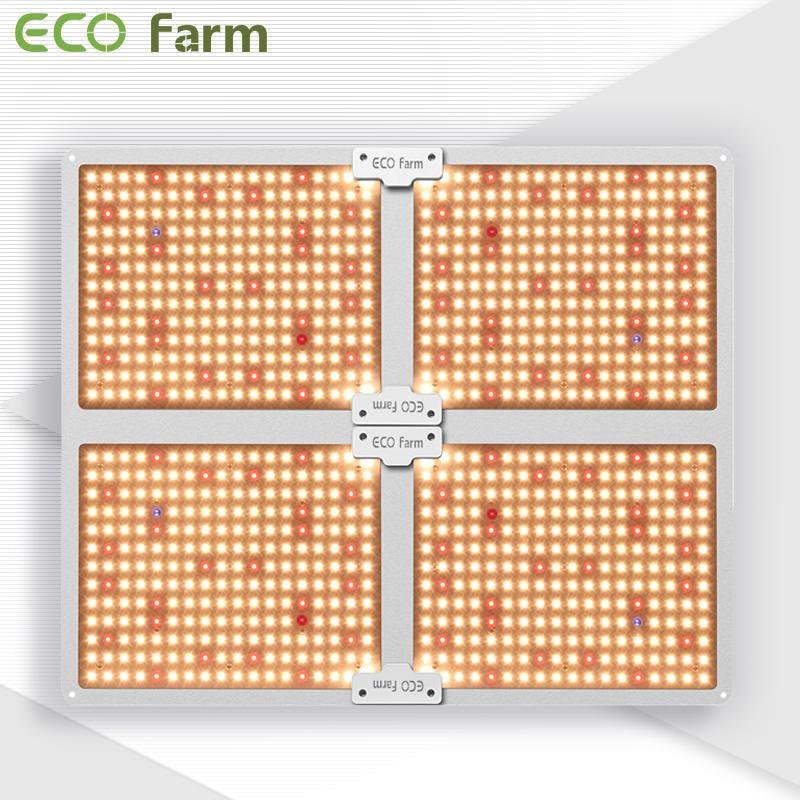
Features:
The ECO Farm grow light is equipped with high-efficiency white light boards with Samsung LM301B diodes, high efficacy 2.7 μmol/J.
White-light full spectrum for optimal canopy penetration and easy viewing.this particular quantum board is one of the best quantum boards that you can find, and, thus, it is almost equally appropriate for all kinds of plants, no matter how big is the area you want it to cover. However, according to several reviews and regarding its power, The grow light is perfect for full-cycle plant growth and specifically good for flowering. Subsequently, it also does a very good job when it comes to veg.Its performance is identical to the 1000 Watt HID system, although its maximum power is 600 Watts. Additionally, it is one of the best quantum boards because it spends less power and produces less heat than some other quantum boards. Its Samsung LED lights emit full spectrum white-light, whose temperature is 3500K. Besides, if you want your plants to have a significant uplift during the blooming stage there is a 660nm deep red light.
AgroMax RAW 550 4000K LED Quantum Board Grow Light
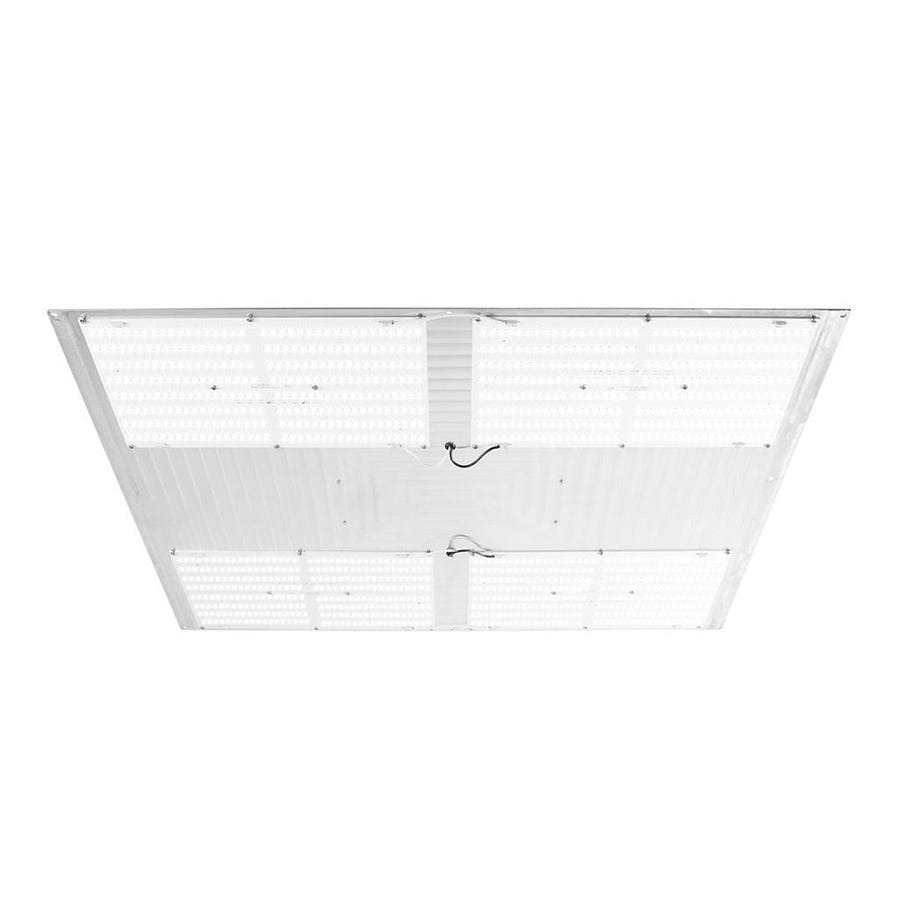
Features:
AgroMax RAW 550 fixtures pair top-shelf Samsung LED Chips with a premium Meanwell driver to deliver industry-leading LED grow light technology. They produce an impressive 2.5 micromole/watt output that is more than capable of supporting 6′ x 6′ of growth space or 4′ x 4′ of blooming coverage. Designed with a sturdy aluminum heat sink and dust/water-resistant conformal coating the AgroMax RAW is also well equipped to withstand conditions in the cultivation environment. The AgroMax RAW 550 is designed from the ground up to maximize the power of Samsung LED chips and Meanwell driver. With an incredible PPFD of 2.5 umol/watt, the RAW 550 delivers more light per watt making it one of the most efficient grow lights available.
How To Choose The Best Full-Spectrum LEDs For You
With so many full-spectrum LED grow lights available, it can be overwhelming to choose the best light that suits your plants.
Here are 5 things to look for when you’re shopping for the best full-spectrum LED grow lights for your system.
1. Spectral Range
Not all LED lights advertised as full-spectrum are actually full-spectrum, and some of don’t distribute the of all wavelengths evenly.
Full-spectrum can’t really be measured, so you have to decide the quality of a grow light based on the manufacturer’s reputation and customer reviews.
2. Draw Power
The actual draw power may be less than the theoretical draw power. If the LEDs operate at very high power (their full capacity) they produce a lot of heat, bringing down the lifespan and efficiency of the light. The low draw power means your grow light won’t emit enough light for your plants.
Vegetative: 30–35 W per square foot
Flowering: 35–50 W per square foot
3. Photosynthetically Active Radiation (PAR)
PAR is the amount of light produced in the 400–700 nm range, which is suitable for plants to use for photosynthesis. The higher the PAR, the better.
PAR requirements for different stages:
Vegetative: 300–350 μmol/s
Flowering: 700–800 μmol/s
4. Photosynthetic Photon Flux (PPF)
The photons that plants use for photosynthesis are called photosynthetic photons. Photosynthetic Photon Flux (PPF) is the total amount of photosynthetic photons (or PAR) put out by a light source.
5. Photosynthetic Photon Flux Density (PPFD)
Photosynthetic Photon Flux Density (PPFD) is the density of photosynthetic photons falling on a surface per second.
The PPFD varies on different points on a given area and also depends upon how close or far the light is from the surface. You shouldn’t buy a light just because its PPFD is high in the middle. You should also check the overall PPFD values at different distances. The higher the PPFD, the better, as your plants will have more access to PAR.
Conclusion
Purchasing a quantum board grow light is a great investment and it’s always hard to pick the best, especially if you are new in gardening and have a lot to learn about it and we hope that this article helped you at least a little bit.
Active Grow Walden White Grow Tent 2' x 4' VS Goliath Grow Tent 2' x 4' x 6'11" Hydroponic Grow Tent
August 06, 2021
At first sight, a grow tent can look like one of those growing supplies, of which you get the first one you can find, and then forget about…
…until you realize you just wasted your money on a grow tent that can’t even correctly handle equipment like a heavy grow light.
For growing plants, your tent should have 2 essential characteristics:
Have a sturdy enough frame to handle heavy equipment, and;
Provide a (close to) light-tight seal.
And better yet: will also last you at least a few years and come with nice growing conveniences, that you’re all going to learn about today.
Sounds good? Let’s get started.
Why Use a Grow Tent?
Simply put, controlling your indoor growing environment is crucial to getting the yields that you want. The first line of defense in environmental control is containing your garden in a confined space — which is what a grow tent is for.
After you have a grow tent, you can move on to other factors that influence your growth like indoor grow lights, growing media, system, nutrients, and ventilation.
How tall of a tent should I buy?
The answer to this question depends on a few things: your lights, your plants, and your own height.
If you are growing with powerful, hot lights like HPS or MH, you’ll need to place them further from the plant canopy and will require more height. On the other hand, if you’re growing with LEDs or CFLs, you can place them closer and get away with a shorter tent.
Some plants also require more height. If the height is an issue for you, you can either grow a dwarf variety of your plants or simply spring for a taller tent to make sure they have enough room to grow.
Lastly, you will likely be inside your grow tent at one point or another. It’s nice to have a tent that you can comfortably fit in. Some of the shorter tents can be difficult to maneuver in.
Active Grow Walden White Grow Tent 2' x 4'
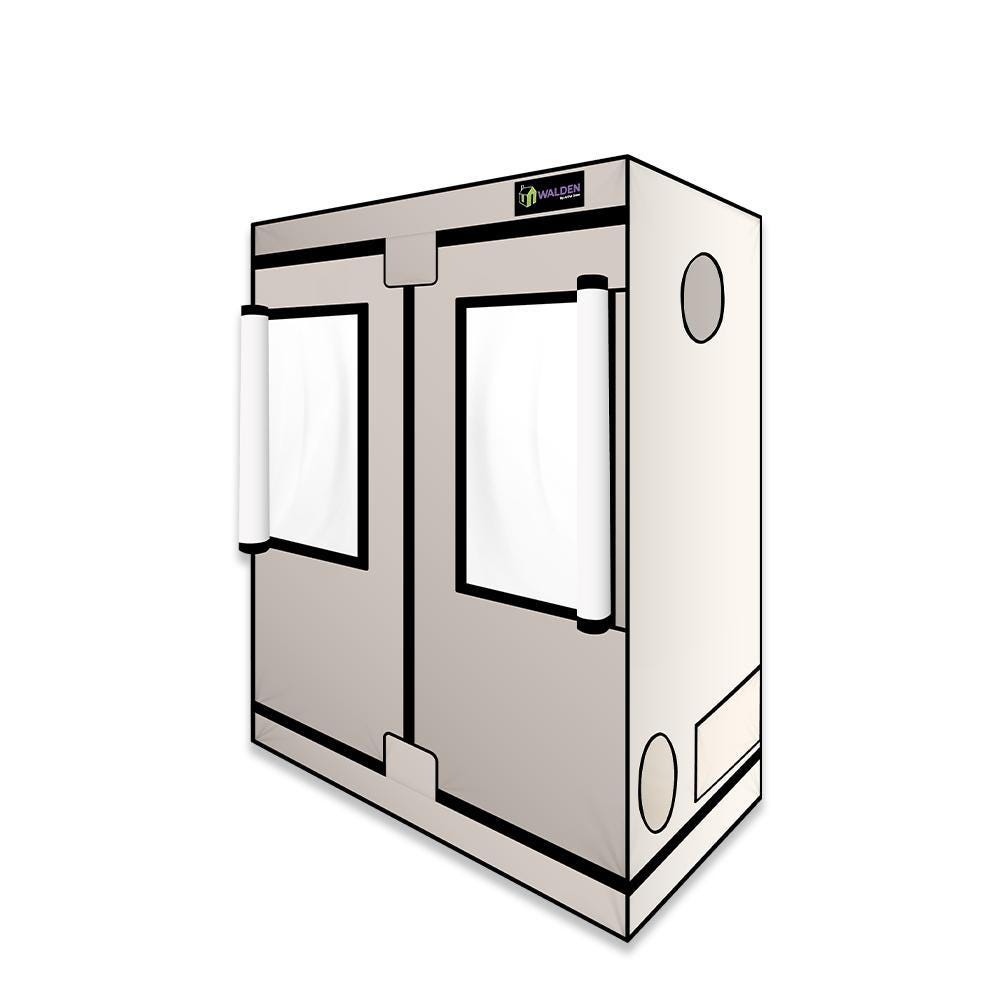
Features:
The Active Walden Grow Tent is designed to give professional home growers a tent that meets their needs in both function and form. All Walden Grow Tents are manufactured using industrial-strength zippers and 100% EcoWhite PEVA material. This toxin-free material creates a clean look for a grow space and emits no hazardous chemical gases, allowing these tents to be safely placed in communal settings without posing any health risks to friends or family. The triple-layer design is composed of a 600D canvas exterior, a vinyl light-blocking center, and a white vinyl interior that is 10% more reflective than even the most reflective mylar tents. The double-wide front doors allow growers to easily access plants or to put them on full display. The Infinity View front windows help growers observe and assess their entire garden without disturbing humidity or temperature.
Goliath Grow Tent 2' x 4' x 6'11" Hydroponic Grow Tent
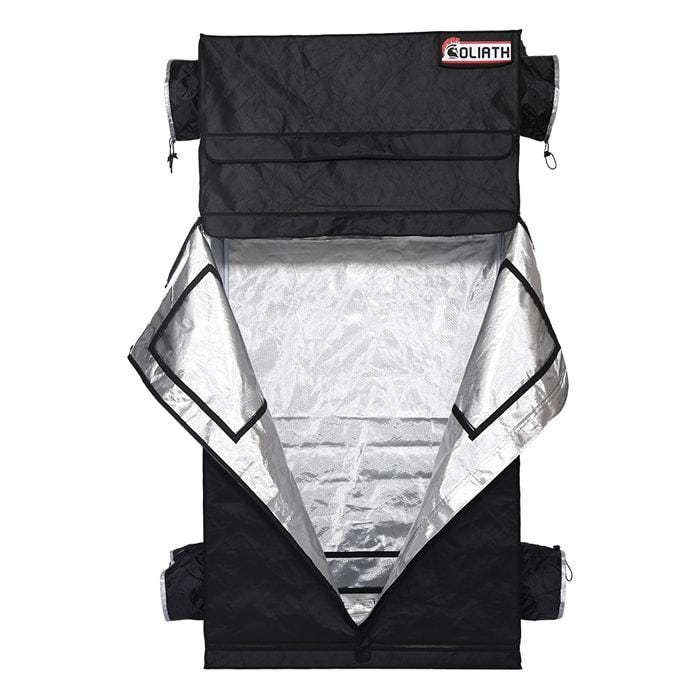
Features:
Professionally designed Goliath Grow Tents are ideal for experts and beginners alike. Expert configuration puts ducting ports in their ideal locations. Large Easy-View windows offer progress view access without compromising your growing environment. Doorways offer 360-degree access. The large configuration provides obstruction-free maneuvering. Maintaining an ideal growing space is a breeze with its thick material and large double cinching duct ports. Diamond Reflective Walls redistribute up to 30% more lumens, making the most out of your growth. Constructed with 1680D thread density fabric that is up to 9x denser than other grow tents on the market. Each tent comes with a height extension kit that allows you to increase your growing height by 12.
Features to Look For in a Grow Tent
The world of grow tents can be confusing if you’re just relying on an online shop or your local hydroponics store. These days there are hundreds of grow tent manufacturers, all with different features, sizes, and price points.
It’s hard to narrow down not only the best brands but what all of the different features actually mean. Too often grow tent manufacturers make up fancy names for their features instead of just calling them by their standard names.
To make it easier, here are the features that you should be on the lookout for when choosing the best grow tent for your garden.
Heat and Rip Resistance
Hopefully, you’ll never need your tent to hold up to extreme heat, but it is something to look for. After all, you’re dealing with hot lights that are hanging in an enclosed space, as well as other electrical parts that are close to water. Accidents can happen, and you want your grow tent to be able to hold up to them.
Fabric Density and Strength
An integral part of the rip resistance of your tent is how dense the fabric is. The fabric density is typically measured in “denier”, which means:
a unit of weight by which the fineness of silk, rayon, or nylon yarn is measured, equal to the weight in grams of 9,000 meters of the yarn and often used to describe the thickness of hosiery.
The densest grow tents are upwards of 1680D, while the average grow tent comes in anywhere from 120D — 600D. As a general rule, buy the strongest fabric that you can afford. It keeps noise and smell in your tent, and it keeps any airborne spores, pests, or diseases out of the tent. It’s also harder for light to leak through a denser fabric.
Quality Reflective Material
One of the biggest advantages of using a grow tent is the reflective properties of the interior walls. It ensures that you’re getting the most out of your indoor grow lights. However, not all reflective material is created equally. You should look for tents that offer reflective mylar with as close to 100% reflectivity as possible. Some manufacturers also offer mylar with different patterns. Diamond patterned mylar seems to have the best reflective quality and some of the top grow tents offer it standard.
No Gapping in the Fabric
One of the main reasons to buy a grow tent is to use your indoor grow lights effectively. The best grow tents are completely light-tight, meaning that when you have your system up and running, absolutely no light should escape. The features to look for here are overlapping velcro flaps to seal off corners and edges, along with zip-draws for any ventilation or cord ports.
Zipper Durability
The zippers on your tent are usually the first point of failure. Because they’re used every single day, wear and tear can build up fast on poorly constructed zippers. They should be easy to zip up, with a large area for your hands for ease of use. The harder they are to zip, the more likely you’ll make a mistake and damage the zipper, letting light leak out of the tent.
Corner Construction
Many grow tents have a plastic, three-prong corner that accepts the framing poles. While these are OK, top-of-the-line tents will have metal corner pieces. The absolute best tents will use corners that have an interlocking snap piece to secure the poles in place, ensuring they don’t wiggle out while moving the tent. This prevents a catastrophic frame failure.
Frame and Pole Strength
Grow tents are almost always constructed by assembling interlocking poles. Some manufacturers offer tents with height-adjustable poles, meaning an extra set of 1’ or 2’ poles that can be attached the vertical supports. These are a great choice if you’re growing plants that require a lot of vertical height.
The poles can be made of plastic, steel, or weaker metals. When in doubt, go metal over plastic, and steel over any other type of metal. Look for poles that have a snapping mechanism to lock them in once you assemble them. The rotation of the poles over time can cause degradation and in the worst cases, a structural failure.
Number of Ventilation, Exhaust, and Cord Ports
There are three types of ports on a grow tent: ventilation, exhaust, and cord ports. Ventilation ports are typically flaps secured by velcro that can be lifted to help vent out hot air. Make sure there is at least one of these on your tent.
Exhaust ports are for more heavy-duty ventilation, including ventilating your grow light. There is typically at least one intake and one outtake port, although larger tents will have more than one of these.
Finally, cord ports. It sounds like a small detail, but having well-placed cord ports is the difference between running extension cords and simply plugging in your growing gear.
Conclusion
I hope this grow tent buyer’s guide has given you every bit of info you need to choose the right grow tent for your unique situation.
Here’s a good way to decide which grow tent is best for you:
Decide how large of a growing operation you are going for
Decide which features matter the most to you
Decide what you’re growing, the lights you’ll use, and how high your plants will grow
No matter what you decide to grow or how you decide to grow it, a grow tent will make your life a whole lot easier — and you’ll have better yields as well! It takes a little bit of time to get used to growing indoors, but after you’re past the learning curve the rewards are too good to ignore.
The Best Bud Trimmer Machines In 2021
August 05, 2021
While a product tended to by hand can add romanticism to an experience, that doesn’t necessarily mean it is a practical method. One useful tool that you can find as a grower will eliminate hours upon hours of hard work: the bud trimmer. Instead of carefully cut by hand to get each individual bud, the bud trimmer does it for you, giving you more time to attend to other things during harvest.
Different types of plant trimmers
There are many different types of bud trimming machines.
Some are made for a big production with conveyor belts or they are smaller in size and can be set up to be used by a trim team in a smaller production.
Each one makes different cuts some such as hand trim looks or just buzz cut.
There are also ones that can be used by the home grower like the trim bowls.
These are compact and ready to use with the dry buds to remove excess leaves off the buds.
There are weed trim machines that can be used for wet and dry buds.
Which Trimming Method is Best?
Any plant grower would agree with me when I say that trimming plant is an art and a science. You need to do it with care for the best outcomes. With this, one of the things that need to be decided upon would be your choice of trimming.
Wet Trimming: This is the more common method and also the one that is easier. When the plant is trimmed while it is wet, it can result in a more manicured look. The buds will look prettier, which is exactly why this is what most people prefer.
Dry Trimming: Under this method, the plant is allowed to dry first. The larger fan leaves also have to be manually removed. This does not only take more time but also more effort on your end.
What are the Types of Bud Trimmers?
Before we discuss the best examples of bud trimmer machines, they can be categorized into two:
Manual Trimmers: These are the ones that are operated by hand, which means that it will require quite an effort. They are usually the cheaper option. Most of the products mentioned below fall under this category.
Automatic Trimmers: It comes with an electronic motor that automates the process of trimming. This is less time-consuming and easier to operate, which is perfect if you are trimming a large batch of weed.
ECO Farm 3 Speed 18 Inch Automatic Bud Leaf Trimmer Machine

Features:
The ECO Farm trimmer is easy to fold design for easy transportation or storage. Quick, effective, and precious pruning and separation of excess leaves, branches, or stems. 3 Stainless steel sharp blade The cutting height of the blade is adjustable. 3-speed motor. There is no metal-to-metal friction. This can prevent heat generation, thereby reducing the viscosity of the resin, thereby reducing resin loss. This also means that no lubricant is needed to keep your buds pure. The bud trimmer uses a long and narrow roller to maximize the cutting surface and speed up the entire leaf trimming operation. The slow tumbling speed means that the flowers are naturally exposed to the cutting surface, thereby minimizing the loss of trichomes. The stainless steel hatch can be opened and removed for easy cleaning. The tabletop is tilted 180 degrees for easy cleaning.
Tom’s Tumbler TTT 2200 Commercial Dry Blade-less Trimmer
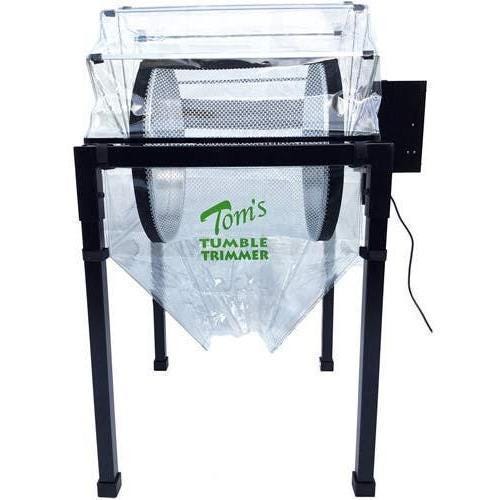
Features:
The Tom’s Tumble Trimmer 2200 is the perfect dry bud trimmer for commercial use or for those who want to increase their daily trimmings. The TTT 2200 can process up to 24 pounds an hour with up to 5 pounds per cycle. With its proprietary Bladeless Dry Trimmer and variable speed noiseless high-torque 50 watt DC motor, your buds will look like they were trimmed by hand, except faster. Made with heavy-duty, powder-coated steel, the TTT 2200 is durable and uses an aluminum axle. With the optional CO2 Infuser Kit*, you can flash freeze your buds or trim while tumbling to speed up the process. The TTT 2200 is easy to maintain. The mesh nets are machine washable, while the pollen net can be hand washed with alcohol. You can also lubricate the zippers with beeswax and cooking oil spray.
Trimpro Rotor Med with Workstation
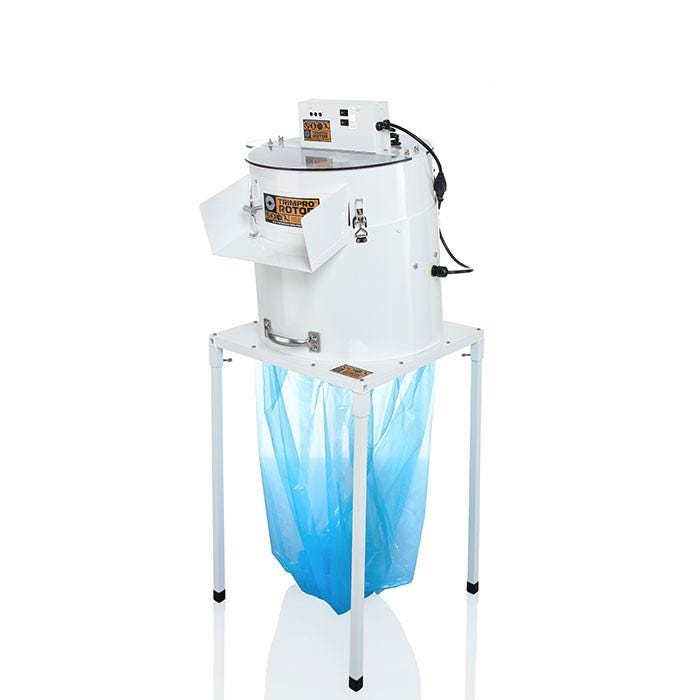
Features:
TRIMPRO ROTOR MED is designed specifically to meet high regulatory demands, with its medical equipment component compliancy, easy and rapid disassembly and assembly, and unique waste management and control characteristics. Each unit is easy to disassemble for sterilization and is just as quickly reassembled, for minimized downtime. The flexible fingers are steam and alcohol resistant. The blade is made from tempered stainless steel and all connectors and attachments of stainless steel. White surfaces are finished with medical standard paint. The Plexiglas hood ensures debris-free operation. With no vacuum component, waste management and cleaning are greatly simplified, further assisted by standard weight, easily removed, and sealed square trim bags.
Pros and cons of using a bud trimming machine
Pros:
Save time when trimming
Save money on hiring extra staff to hand trim
Speed, it is very fast and can be automatic
Trim a large quantity of plant
Cons:
The trim usually looks like a buzz cut and all buds are all uniforms.
There is more waste from the buds than hand trimming.
Lose a large amount of the trichomes, means weaker cannabis being sold.
Can get clogged and break down
What to look for in a bud trimmer
Here are some of the things to look for in a bud trimming machine.
Size, there are lots of different models depending on the size of your needs. Are you a big producer or a small home craft grower?
Quality of the trim, do the buds come out nice and uniform, some have it look more like a hand trim was done to the plant buds.
Function, of the unit, do you require it to be automatic and hands-free or use a manual crank.
Dependable, the machine should not get clogged too often or it’s a smooth operation with little maintenance over time.
Easy to Clean, with growing plants there is lots of resin ( which means sticky) and also precious thc/cbd trichomes that can be recovered and utilized. The trim must be easy to remove as well.
What to do with leftover trim
The best things to do with the leftover trim from a large producer to the home grower are the following.
Use screens and trim trays to collect the precious kief left over from all the trim leaves and material in the trimming bags or bins.
Make edibles out of the sugar leaves and trim a growing trend in the market and a great way to get the most out of your cannabis plants.
Edible oil can also be made from the trim out of either olive oil or mct oil.
Rosin or concentrates can be used with the kief or leftover trim ( key ways to make it safely out there)
Conclusion
In this review, we showed you the best bud trimming machines out there and all the various sizes and models to choose from for your required needs.
A bud trimming machine saves an enormous amount of time and increases efficiency in your employees if you are a big producer.
For the home or craft grower, some of these trimmers can help get you more time back in your day to focus on other things than being stuck in trim jail.
CenturionPro Dry Batch Trimmer Model 1 VS Triminator Mini Dry Portable Trimmer
August 04, 2021
After waiting patiently for three months, your plant is finally ready. Your crop is looking nice and smelling great, and you’re super anxious. At this point, all you are thinking about is harvesting it at the least amount of time possible…But Wait! How do you even cut it without wastage?
As much as you’re super hyped about harvesting your plant, you need to be careful not to destroy the buds. After all, you have worked hard for this. What you need to do though is invest in the best trimmer that the market has to offer.
The type of trimmer you would like to harvest your cannabis with will depend on your needs. Are you a person who likes to enjoy the whole harvesting experience with a snip- snip manual harvesting? Do you like a quick harvesting time with an electric trimmer? Or do you need a helping hand during your harvest? All these questions will help you decide on the ideal trimmer.
Why Should You Learn To Trim Your Buds Right?
Trimming is important to help make your trimmed buds look good. In addition, it allows them to have a uniform appearance and can raise the levels of THC in marijuana. When you trim, the buds become compacted and you can improve the quality of the plant.
There’s a perception that trimmer machines can damage buds. While this can be true, it’s important that you select a non-stick tumbler, which will process the bud quickly and without as much trichome damage. You can also always adjust the trimmer blades to make your job less risky, too.
Kinds of Bud Trimming Machines
Bud trimmers today are classified into three different kinds: manual, automatic, and industrial. The difference mainly revolves around the use and the size of crop they can help harvest.
Manual Bud Trimmer
This type works manually, i.e. more labor on your part. Still, it is easier than going with the trim tray option. You operate the machine that trims the buds and many growers actually prefer this type of trimmer. It is the best bud trimmer if you have a small grow tent.
Automatic Bud Trimmer Machine
Fully electronic bud trimmer that does the job for you. All you have to do is plug it in and run it, and the rest is the machine’s work.
These automatic trimmers have seen consistent improvement over the years. They are easy to work with and a lot faster in comparison with manual trimmers.
Industrial Bud Trimmers Machine
Industrial trimmers are essentially automatic trimmers that are way more powerful and designed for trimming large crops. For that reason, they are quite expensive too.
CenturionPro Dry Batch Trimmer Model 1
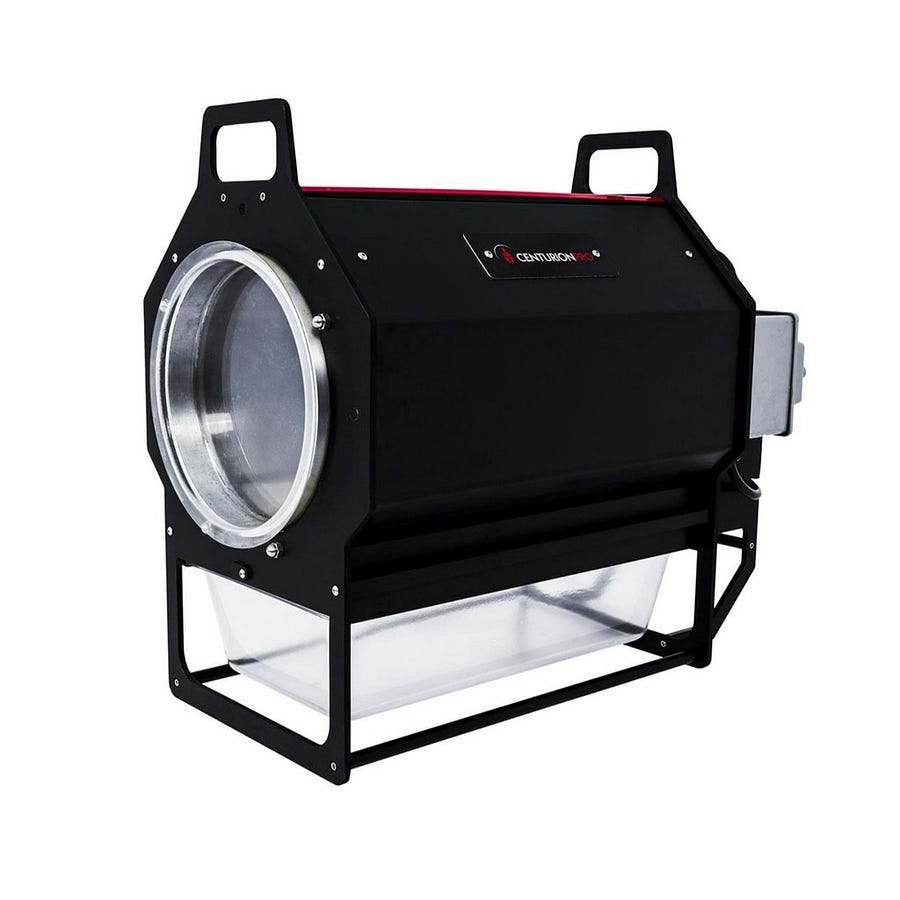
Features:
The CenturionPro Bud Trimmer is the most cost-efficient dry batch trimmer on the market today. Designed to harvest delicate dried flowers, this model has a trimming capacity of up to 8 pounds per hour (dry) so it’s perfect for home growers and small harvests looking to simultaneously streamline their processes. The CenturionPro DBT Model 1 Dry Batch Bud Trimming Machine protects your precious terpine profiles featuring soft tumble technology that applies the perfect cut every time, regardless of flower size, shape, or density. The CenturionPro DBT Model 1 offers an optional Kief Filter Screen that collects any trichomes that detach, maximizing your harvest’s value. These dry batch trimmers are constructed from high-quality stainless steel, using the best brand name parts to bring you an elite harvesting solution built to industry compliance.
Triminator Mini Dry Portable Trimmer

Features:
The Triminator Trimmer is designed for growers who prefer to trim dry, and need the job done fast. Now, even hobbyists can achieve an automated harvest! This award-winning portable trimmer works quickly, quietly, and is incredibly user-friendly. It produces an immaculately trimmed bud and is built to withstand the test of time. You can trim up to 2–5 pounds an hour, and can even use the optional pollen tumbler kit to maximize productivity. The ideal moisture level for Triminator Dry Trimmers is between 9% — 10% Proprietary material reduces the need for lubricants and reduces friction by eliminating metal on metal interfaces. Pure Trim technology keeps the product cooler, which reduces resin loss and stickiness, and produces the highest clarity extracts.
Choosing the Best Trimmers for Weed — the Ultimate Buying Guide
For the longest time, you have waited for your plants to mature. You have just had a bounty harvest, and you need to trim the buds into smaller pieces. Just which device should you use? The best trimmers for weed are easy to find if you know what to look for. Pick a device that is both affordable and provides weed of the highest quality. Before settling on a specific trimmer, the following are some of the questions you need to ask yourself:
Will You Be Trimming Wet Or Dry Buds?
Every plant grower prefers to do things in his or her own way. While some prefer to trim wet buds, others would rather dry them first. Most growers would rather trim their weed dry. However, that can pose a challenge, especially when stems and leaves tightly wrap around the buds. That can make the trimming process a little too difficult.
The option is to trim your buds wet. While it is easier, it may prove to be a messy affair. However, that is quickly forgotten, given the resultant high-quality buds. So, if you prefer dry trimming, buy an appropriate device.
On top of the trimming method, consider whether there’s the need to collect and save the trimmed plants for future use. Certainly, there are several trimmers with features that are likely to assure you of a highly potent product.
How Many Plants Do You Have?
Most plant growers may just have a few plants for their personal use. Others might have several plants in a wide area, mainly for commercial sale. If you fall in the first category, what you need is a small device akin to a pair of scissors. For commercial plant growers, buying one of the best trimmers for weed is of the essence. In the same breath, you will have to decide whether to buy a manually operates trimmer for weed or an electric one.
Is The Trimming Taking Place Indoors Or Outdoors?
Not all trimmers for plants can be used in the outdoors. Some require to be used in the indoors where the temperature is not extreme. Others are made of materials that can withstand the hot sun and thus, are great for the outdoors. The best trimmers for weed that are suitable for outdoor use are those made of polished stainless steel. When made of aluminum, a trimmer will be best for the indoors. So check the material from which it is made and buy depending on whether you need to use it indoors or outdoors.
Conclusion
The best trimmer will not only be easy to use, but it will offer minimal mess and minimal trichome loss. It won’t damage your buds and will be easy to maintain and clean. While there are various sizes, price points, and features to consider when you are buying the best trimmer for your needs, there are several types of bud trimmers that will work for all grow sizes, regardless of whether you are growing commercially or as a hobby.
TopoGrow Professional 800W LED Grow Light VS Mammoth Lighting Commercial Series 10 Bar 800 Watt LED Grow Light
August 03, 2021
When growing plants indoors, replicating the effect of sunlight is often the biggest hurdle. Sodium, fluorescent, and HID lamps emit too much heat and are very power-hungry.
Modern LEDs are superior in these two aspects. Check out our review and the buying guide to learn how the best LED grow lights can improve your hydroponics/aquaponics system.
What type of LEDs do you need?
There are two options: full-spectrum lights, and separate vegging and blooming lights.
Full-spectrum lights are all-around products that can provide adequate lighting for a plant throughout its life cycles.
But in some situations, you might be opting for a more focused approach. For example, your system may be having separate growing areas for the growing period and flowering periods.
In such conditions, you can opt for a vegging LED light for the growth stage, and blooming LEDs for the flowering stage.
Many good-quality full spectrum lights these days come with programmable settings. With these, you can opt for veg or blooming light settings depending on the age of your plant.
How Many Watts Do You Need To Grow Cannabis Indoors?
Wattage doesn’t accurately determine coverage area when it comes to LEDs. It is a measurement best suited for HID / MH / HPS lights, but it’s often used to approximate LED coverage area.
PPFD (photosynthetic photon flux density) and DLI (daily light integral) are the correct metrics to use in order to determine the number/power of lights required. For the purposes of this article, we will be using wattage to approximate the coverage area, which doesn’t need to be much more than the area your cannabis plants occupy.
The flowering cycle requires the most intense light, so we will be estimating watts based on this phase.
On average, an LED grow should use a minimum of 32 watts per square foot, ideally closer to the 50–80 watt range.
Consult the grow room sizes below for a quick guide to how many watts you’ll need:
1’ x 1’ : 32 watts
2’ x 2’ : 128 watts
3’ x 3’ : 288 watts
4’ x 4’ : 512 watts
5’ x 5’ : 800 watts
6’ x 6’ : 1152 watts
TopoGrow Professional 800W LED Grow Light
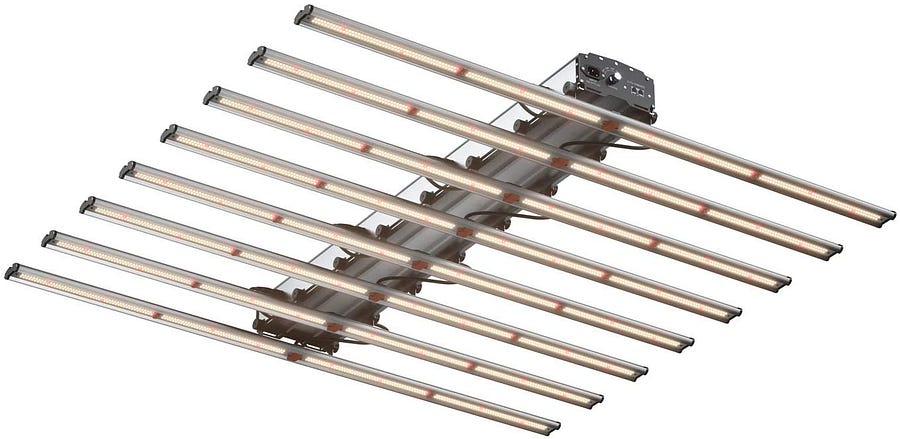
Features:
Durable IP65 waterproof aluminum material used, Branded led chips and drivers provided. high Efficiency is 2.6 umol/J, delivers a powerful light output and uniform canopy penetration to resulting maximum higher yields. PPF is 2080 umol/s, maximize yield with 50% higher Average PPFD, achieve 60% higher yield & quality compared with the traditional led lights. Consume power is 800W, make it a High-End and High-Performance commercial grow light. utilize the latest in high yielding LEDs technology today, max yield Spectrum with enhanced red 660nm led chips and warm 4000K led chips, it speeds up blooming & fruiting stages, perfect for Density Buds. The light could be used for commercial, home, grow tent, grow room, hydroponic, soil growth. this 800W led grow light is best for 6x6 FT growth.
Actual Power:800W
Numbers for light bars:8
Input Voltage: 100–277V
Mounting Height:≥6”(15cm)
Lifetime: 50000hrs
Chip: Samsung LED LM283B+Chips.
Color rendering index:90ra
Power factor: >90%
Ambient temperature: -40–40℃
Manual Dim:350W/500W/650W/800W
Mammoth Lighting Commercial Series 10 Bar 800 Watt LED Grow Light
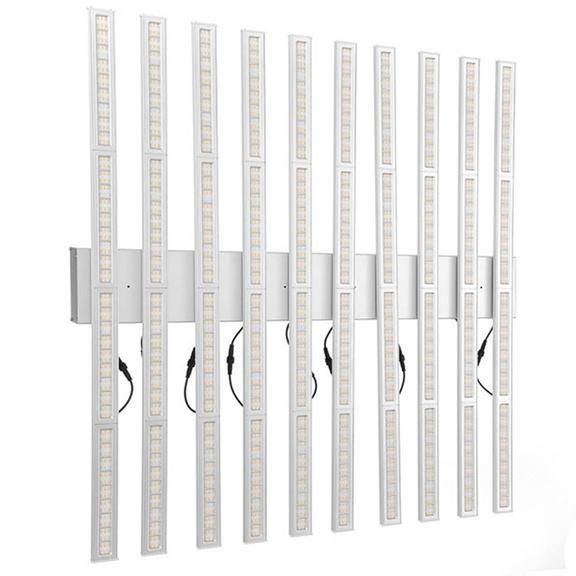
Features:
Mammoth Lighting has been developed by indoor growers over many years of careful experimentation and testing. Scientifically engineered to deliver the highest level of PAR output and balanced Coverage in the LED grow the market. At 2159 µmol/s of PPF and a PAR rating of 2.7 umol/J, the Mammoth Lighting 10 Bar fixture measures up to the best LED Grow Lights on the market. Compare this to Fluence SPYDR 2i @ 1700 µmol/s. Lower your cost and increase yields! The Mammoth LED grow lights are built with high-quality Samsung diodes. The lights encompass a continuous range of wavelengths from blue and green to red, creating a light blend matching the natural sunlight. We customized our light spectrum to optimize plant growth and increase yields while consuming less energy and reducing operating costs compared with traditional horticulture technologies.
Power 800 Watts
Samsung Diode LM301B SK
PPF µmol/s 2159
PAR µmol/J 2.7
Veg Coverage 7' x 7'
Flowering Coverage 5' x 5'
Voltage 100V-277V — 120V standard
Spectrum 3500k + 660nm
Power Factor >95%
THD <6%
Fixture Lifetime >=50,000 hours
The Best LED Grow Light — A Buying Guide:
Choosing the right LED grow light is important if you want to get the absolute most out of your indoor plant growth. There are a few key things to look for when considering the best LEDs for your growth, but a lot comes down to your personal needs and budget.
Full-spectrum LED grow lights are more costly than broad-spectrum models, but they provide the best results as they closest mimic the sun’s spectrum.
LED bulbs emit less heat than other grow lights but they still radiate some heat, especially the larger, higher wattage models. Look for options with built-in heatsinks and fans that pull the heat upwards and away from your indoor plants.
A single LED lamp will only provide enough light for a certain area. Depending on how many plants you’re planning on growing, you may need a large light, or perhaps multiple. The LED grow lights reviewed above all have a coverage area specified to help you gauge how many lights you’ll need to complete your grow room.
Purchasing your grow light from a trusted manufacturer is important for a number of reasons. Not the least of which is the fact that they often offer a limited warranty for added peace of mind. Buying quality LEDs will help protect you from technical difficulties. Replacing a light halfway through a grow can be a big problem, not to mention a costly one. A quality LED light panel should last anywhere between 50,000 and 100,000+ hours, so you won’t need to worry about replacing them for a while.
Conclusion
Choosing the top grow lights for your indoor grow doesn’t have to be a confusing and daunting endeavor. We’d suggest going with LEDs regardless of the size of your grow or your experience growing plants, they’re simply the best in our opinion. It will be slightly more costly initially, but well worth the price when you take into account the convenience, quality, and lifespan that LEDs offer. Our hope is that the best LED grow lights reviewed will supercharge and simplify your indoor grow.
Best 660W LED Grow Lights For Your Plants
August 02, 2021
Growers have relied on artificial light sources for indoor farming for decades. Whether you are using soil, aquaponic, or hydroponic system, these light sources all have different levels of effectiveness. Fluorescent, Pressure Sodium, HID, and LEDs are all made to mimic the sun’s rays indoors. In this article, we focus on LED Grow Lights and how to choose the best LED grow light.
How Much Light Do You Need to Raise Plants Indoors?
Some plants require lots of light, others tolerate shade. The first thing you’ll need to do is get acquainted with what your vegetables and herbs need to flourish inside.
General rules of thumb for raising vegetables indoors:
Root vegetables like carrots and onions need at least six hours of sun or light
Leafy vegetables like lettuce need at least four hours of light
Vegetables like tomatoes and peppers (fruiting plants) need the most, at least 8 hours
Less light is good for germination and sprouting, but fruiting and blooming requires more light
That gives you an idea of how much time you’ll need to run the lamp to supplement winter sunlight, but how big or powerful of a lamp will you need for all your plants?
Choosing the right size light for the best coverage and a healthy garden
Lumen ratings measure brightness for human eyes, so they aren’t very helpful for selecting grow lights. Wattage is a measurement of power, but this isn’t helpful either, except for judging how much electricity the light will use. Instead, look at specifications on PAR and the manufacturer’s guidelines on square foot coverage.
PAR
PAR means photosynthetically active radiation. It’s a measurement of the light’s intensity and what colors it emits. PAR measures light emitted in the 400nm to 700nm spectrum, or from blue light into infrared. The higher the PAR number, the more useful the light is for growing plants.
Coverage
Most manufacturers will state information like the area their light covers at certain heights above the canopy of the plant. For example, one might say their lamp illuminates 4 feet by 4 feet at a height of 18 inches. When you’re germinating seeds, you may hang a bright light up higher than this, and therefore you’ll have a larger coverage area.
But when you’re trying to get tomatoes as big and juicy as possible, you’ll want to lower the light closer, which will shrink the area it covers.
Other factors to note
One LED panel may not be large enough to cover all the plants you want to grow. You might need two or more. Look at whether the manufacturer allows daisy-chaining or has another method so you can link the lights together and run them off the same timer.
Take into account the shape of the panel or light, whether it casts a circle, square, or rectangular of illumination. Remember that the light will need to be powerful enough to penetrate foliage in a few weeks. It’s better to buy a more powerful light than you think you’ll need.
Now let’s review the best LED grow lights for growing plants at your homestead.
ECO Farm ECOM Bluspec 650W LED Grow Light with Samsung LM301B and Cree Chip

Features:
The ECO Farm grow light is equipped with the highest quality and high-efficiency Samsung, Osram, CREE LED, and 8 high-efficiency aluminum rods to ensure high-efficiency PPE 2.7umol/J, better heat dissipation, and long service life. 8 LED growth The lights, each rod is covered with high-grade glue, waterproof and easy to clean, not easy to be filled with dust. The nano-material primary coating ensures durability and cleanability while maximizing efficiency. At the same time, it also has an ideal full-spectrum and amazing heat dissipation, close to natural sunlight. The spectrum applies to the entire stage of indoor planting. Efficiency and spectral stability are of paramount importance. The largest heat sink in the LED grow light can provide excellent cooling and extend the life of the LED. The super-efficient LED has a rated life of more than 70,000 hours
FLORAFLEX® LED GROW LIGHT- 650–8 BAR LED Grow Light for Your Indoor Plants

Features:
FloraFlex’s new grow light is a high-performance and cost-effective lighting solution for indoor cultivation. Featuring a balanced spectrum, incorporating a 3K CMH Full Phase Spectrum for superior growing power. With onboard dimming function, our growers can set the ideal strength for any stage of plant growth, giving total control. Full cycle LED grow light designed to target only the parts of the spectrum your plants need to thrive through both vegetative and flowering cycles. At 660 TRUE LED watts, the grow light is the equivalent to approximately 1100 HPS or metal halide watts, meaning, it runs on nearly half the wattage of traditional grow lights.
Optic LED Slim 650S Dimmable LED Grow Light 650w (120 Degree) 3500K (UV/IR) LH351H

Features:
The Optic Slim 650S is the first-ever bar light fixture to deliver 3 way spectrum control. It has independent dimmers for red, blue, and white LEDs. The Slim 650S is engineered to give you performance far beyond what any other LED grow light company has on the market today. It features the new Samsung LH351H deep red LEDs rated at 3.1 umols/J and the Samsung white LM301H LEDs which are above 3.0 umols/J. Royal blue, IR and UV round out the spectrum. Each Samsung and CREE diode has a 120 degree lens for protection and to focus the beam for better efficiency. The Slim 650S is one of the most advanced LED Grow Light ever manufactured. Slim 650S when combined with our touch screen master controller gives growers the power to recreate mother nature with precision accuracy.
Are LED Grow Lights Any Good?
Judging LED grow lights are good or bad depends on whether they can bring us help or benefit. The normal growth of plants needs sunlight and LED grow lights are artificial light sources that simulate the sun’s rays, so it is beneficial to plant growth. In the direction of agricultural development, LED grow lights are good. Using LED grow lights can increase the yield of crops, greatly shorten the growth cycle of crops, and increase farmers’ income. Using LED grow lights under greenhouse cultivation, crops can be planted all year round, but the planting time under the sun is reduced by half. In the rainy season, many crops will die because of not seeing the sun for a long time, and the crops have no harvest nothing. Planting plants under LED grow lights, it will not lose harvest because of the rainy season. Therefore, we can draw a conclusion: LED grow lights are beneficial to plant growth and provide technical support for increasing food production. It will definitely be a starting point for the development of modern agriculture.
Things To Consider
When looking for a set of LED lights, it is best to get a set that is quality and will suit your needs.
If you choose a set based solely on a lesser cost, you may end up with a product that costs you more in the long run.
Time and effort and your original plants could be ruined if you don’t have the right lights.
It pays to research the types of lights available and what you need regarding your growing. Set your goals and educate yourself on what you need to get there.
It is seldom a good idea to skimp on costs thinking that you will upgrade at a later date when you can afford it.
If you don’t set up your process correctly from the beginning, you may not have a later date to count on.
When looking for LED lights, consider the following important information:
Quality
You want your grow lights to be durable. It can be extremely frustrating to have to replace lights a short time after purchase, or in the middle of a grow cycle.
A quality LED light should last about ten years. We may be biased, but we believe that a product manufactured in the United States according to high industry standards, is the place to start looking.
Brand Name
When you start looking, you will find numerous brands and manufacturers on the market today.
If you are looking at different lights that are comparable, check out the brand.
As with most other items, go with a brand that has a good reputation. If you have any difficulties, you want a company that will stand behind its product and provides excellent customer service.
Energy Efficient
You will be expecting a lot from your grow lights. They will need to be functioning for at least ten to eleven hours each day.
That is a big draw on the amount of energy you will be using. You want a product that will be easy on your electricity bill.
Check how many units the light is in total output. Anything less than 300W will cost you.
Choose something that is on the higher end of 600W to 800W or more. The higher output will compensate for any wattage loss.
Heat
Because the lights are in constant proximity to your plants, you want to make sure that the lights will not be damaging the plants by the heat that they emit.
Another thing to consider is that lights that have a higher heat output will also burn out faster.
Semiconductor Chip
An LED’s light core converts electricity to light and determines the wavelength of that light.
The chip needs to have at least 3W to be able to provide sufficient illumination.
Plants
What will you be growing? Certain LED lights are made to supply the needs of specific plants. It is not always a one-size-fits-all with LED lights.
Depending on the plant, it will need different wavelengths during each growth stage. Tomatoes will require a different type of light than flowers.
It is also essential to consider if you are doing just vegetative cycles or if you are doing flowering and growing processes too.
Space
This is a significant factor. What is the size of the area you will be growing in? As a general rule, you will need 32 watts of actual power per square foot.
Again, it depends on the plants that you are growing. Some plants take less light (like lettuce), and others take more (like tomatoes).
You will need to determine the amount of light your crops will need.
Easy to Use
There may be times when you need to adjust the position of your LED lights. If you get a quality light, it will also be able to be adjusted with ease.
Look for lights that have both wavelength and light intensity adjustments. Ease of maintenance is another important factor.
Full Spectrum
An LED is not just an LED when you want the light to simulate the photosynthesis process. The process requires different wavelengths, as we mentioned earlier.
You will want an LED that can deliver the full spectrum needed throughout every stage of the growth process.
Some plants need light in the red and blue range along with the light being infrared and ultraviolet. A quality LED grow light will be able to provide these variations.
Warranty
Last but not least, you are going to want a light that has a good warranty. Whatever light you choose should have a decent warranty and even free return shipping.
Conclusion
There are a variety of things to think about when looking at what LED grow light you should purchase. Use the above factors as a guideline when considering what you need.
If you purchase a quality product, it will cost you upfront, but inferior products always end up costing you more in the long run.
GIB Lighting 630W LED Grow Light VS Omega Luna 630w Led Grow Light
July 30, 2021
Grow lights are the replacements for natural sunlight indoors. As and who the sunlights are essential for the growth of plants, providing befitting grow lights for your indoor grow is that much of importance.
Grow lights are generally used in horticulture, indoor growth, plant propagation, hydroponic growth, and aquatic growth. Depending on the cultivation stage (vegetative, flowering), plants require different luminous efficiency, range of the spectrum, color, temperature, and photoperiod for their optimal growth.
In recent days, LED grow lights shine out a lot because of their flexible design, utmost performance, conservative energy output, efficient heat-light production, and low voltage operation, and more.
What do the Different LED Lights Means?
As you’ve probably seen in the product reviews above, there are quite a few different LED lights that come with these models. You’ll often find four main types: red, blue, UV, and IR. Each of these colors works to help your plant's growth process in a unique way. The red light is meant to help with the blooming process. The blue light will help to create photosynthesis that your plants need. UV lights help with seeding, and the IR light is important to help encourage blooms in your plants.
To be more specific, the red light helps with plant growth. If you want your plants to quickly start flowering, this is a good color to use. Red is ideal to shine on your plants during their early growth stages.
Blue lights are meant to help your plants produce not only photosynthesis but chlorophyll. This will help your plants to produce strong leaves and stems. This means it will work to stop the plant from wilting.
UV lights are also best to use in the early growth stages. They work to help produce defense proteins in your plants which works to strengthen them. This can also lead to the plant has better color and taste because it is healthy and strong. IR lights are mainly used to help produce photosynthesis in plants. Often these lights are paired with red ones to help plants grow quicker.
You’ll also sometimes find dim lights that are built into your grow light. These dim lights are specially designed to help prevent your grow light from overheating. This can also prevent it from getting the plant too hot which could end up burning it.
What Hanging Height Should I Use?
It’s important to use the correct hanging height with your LED grow light. Using the wrong height could end up destroying your plants due to burns or could even end up making it difficult for the light to reach your plants to help them grow.
How high you should hang your LED grow light mainly depends on the wattage your grow light has. If your grow light has a 150W you’d want to hang it about 10 inches away from your plant. If you have 400W you’d want to hang your grow light about 14 inches away, and with a powerful 1,000W grow light about 22 inches.
Something else to remember is that further away is often better. Sometimes it can seem like the closer you hang these lights the better your plants will grow. This isn’t always true. It’s best to usually keep the grow light a little further away from your plant just to be on the safe side. So, if you’re having difficulty with figuring out the proper length, it’s best to hang it a little higher than the plant. Usually, this is about 18 inches from the plant.
GIB Lighting 630W LED Grow Light
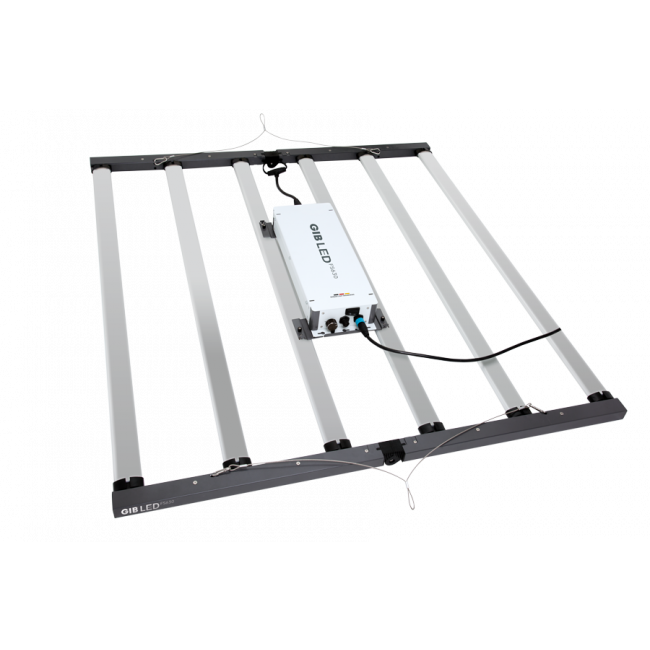
Features:
The GIB grow light is equipped with the high-quality OSRAM OSLON® full spectrum LED chips that offer a performance of 1575 µmol / s with an excellent efficiency of 2.5 µmol / J. It is suitable for the entire life cycle of the plants and can ideally illuminate 2 x 2 m in the growth phase and 1.5 x 1.5 m in the flowering phase. Due to the passive cooling without a fan, the FS630 works completely silently and is less prone to technical problems. The service life is specified as at least 50,000 hours. Compared to conventional HPS / MH plant lamps, the GIB Lighting LED FS630 630 watts can achieve 30–40% more power. 6 LED strips with heatsinks and a projection angle of 120 ° offer optimal light distribution. By reducing heat emissions towards the plant, a very tight installation is possible. Between 25 and 37 cm from the tops of plants. This allows the luminaire to be used in low rooms, growing racks, vertical gardening, and growing tents.
PPF: 1575 µmol / s
Efficiency: 2.5 μmol / J
Beam projection angle: 120 °
Lifespan:> 50,000 hours
Power: 630 W
Input voltage: 100–277V
Frequency: 50/60
Max. input current: 6.2 A
Power factor: 0.9
Driver efficiency:> 90%
IP protection class: 54
Operating ambient temperature: 0 ~ + 40 ° C
LED type: OSRAM OSLON®
Omega Luna 630w Led Grow Light
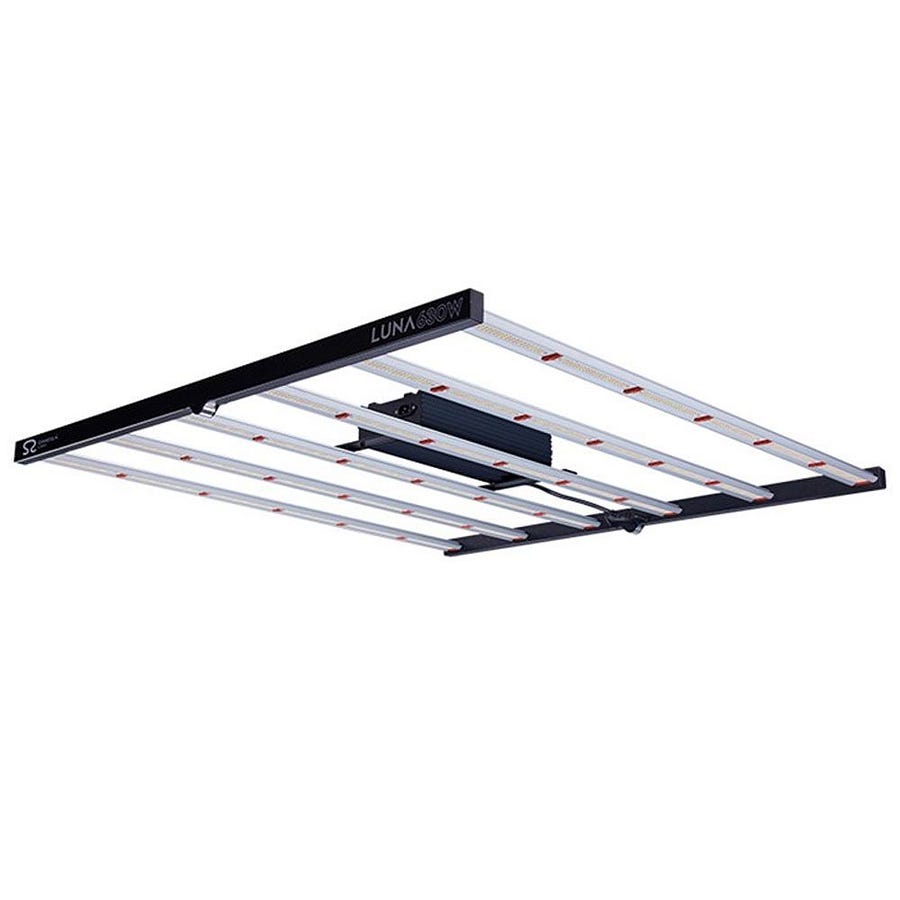
Features:
Consuming only 630 watts of power the Omega LUNA 630W Grow Light uses the professional LED Chips from Samsung 2835 & Osram red Diodes and is fully dimmable to 250, 380, 500 & 630 watts. Providing the same amount of light as an HPS lighting — but consuming less energy and giving off less heat, heat management will be much easier to manage. Running super cool in operation and with a life span of around 50,000 hours or more, your plants are in for a real treat as they receive a full spectrum LED suitable for the full growth cycle at a photon efficacy of 2.6 µmol/J. Specifically designed to provide uniform levels of PPFD across your plant canopy, therefore you can expect more yield at harvest as the full spectrum is emitted across the plant canopy and is not wasted on grow room walls.
LED Samsung 2835 & Osram Red Diodes
Photon Efficacy (fixture efficiency) of 2.6 µmol/J
PPF : 1650 µmol/s
Silent passive cooling system
Dimmable : 250, 380, 500 & 630 watts
Footprint coverage: 1.5 x 1.5m
Fixture Weight : 12.5kg
Fixture Dimensions: 116 x 70 x 13 cm
What to Look for in the Best Lights for Weed?
There are some features every good grow light should have. Here’s how to assess some essential aspects to check if the light will work for you.
Light Proportion
First of all, take a look at the light proportion. That’s whether the grow light is full-spectrum or not. This depends on the plants you intend to grow, but for indoor plants, the best option is to go for a full-spectrum combination that mimics sunlight.
However, if you want fast growth and higher yield, you can go for LED lights with more UV and IR proportion.
Energy Efficiency
Energy bills will take up most of your grow room costs. But, you can avoid spending too much by investing in an energy-efficient grow light. Look for a light that gives out a high lumen output while using minimum energy.
Heat Management
Most of the cheap grow lights available online run bright and hot, damaging your plants in the process. That’s why you should look for lights with a productive heat management system.
Aluminum panels with vent holes do a great job of cooling the lights down while they run. Some lights also have one or more than one cooling fan to regulate the temperature in your grow room. Make sure the fans operate noiselessly; otherwise, you’ll have to find a secluded place in the house for your grow room.
Tips for Operating Weed Grow Lights
If this is your first time setting up a grow tent, you’ll need to learn the basics about grow lights to know how they work.
Don’t keep your grow lights running all day. Your plants need rest. Give them at least six to eight hours of nighttime each day.
Keep changing the placement of your lights with different growth stages. In the beginning, fix the lights about four inches away from the plants and take them further as the plants grow.
Water your plants according to the lights you use. Plants under LED lights don’t need much water as there is minimum evaporation. In this case, excess watering might damage the plants.
Conclusion
Now that we’ve shared our picks for the best led grow lights, you will find it much easier to choose one that works best for your needs. These products are not the same, because they are meant for different areas and have various features. Whichever one you pick, you should know that you’ll be getting a bang for your buck.
Best LED Grow Lights for 4*4ft Grow tent Under $600
July 29, 2021
LED grow lights intended for large spaces can be expensive. Many grow lights on the market today are either inefficient, don’t properly cover the stated coverage area, or are grossly overpriced. When you’re spending $1,000 or more on a LED grow light, you want to make sure that you’re getting not only a high-quality product that will last several years but also a LED grow light that is efficient and evenly covers the grow space with light.
In this article, I will reveal my picks for the Best LED Grow Lights in 2021. This list will include LED grow lights under $600 that has a flowering coverage area of 4’x4’ and are best for a full-cycle grow (from seedling through flowering).
Do LED grow lights work?
LED grow lights do work if you use them carefully according to the manufacturer’s instructions. Different LED grow lights are ideal for plants at different growth cycles.
Ensure that you have used the correct wattage, hang them at the recommended height and regularly monitor them to ensure they are working properly as intended.
Why is the light color spectrum important to plants?
Plants growth is achieved through the process of photosynthesis. In order for photosynthesis to occur, one of the requirements is the source of light.
However, different light color spectrums have different wavelengths either short wavelengths or long wavelengths and they produce different energy levels.
When plants absorb a given light color it has an impact on the energy levels that the plants consume.
Purple/violet light color spectrum are short wavelengths and they have the highest energy levels while the red light which is at the other end of the light spectrum is a long wavelength and produces less energy.
The blue light color is ideal for plants at the vegetative stage while a blend of red and blue is perfect for plants at the flowering stage.
With the current LED technology advancement, there are best LED grow lights that are full spectrum making it possible for the grower to adjust grow light requirements at different stages of plant growth.
What are the advantages of LED grow lights over other traditional models?
Why settle for the best LED grow lights for indoor plants over other models? There are many benefits of using LED grow lights in your indoor garden as opposed to other models such as HPS.
The following are the advantages of LED Grow Lights;
They provide high performance while at the same time being energy efficient
LED grow lights have a longer lifespan thus, giving you value for money
The full spectrum LED grow lights can be used to grow plants with different growth cycles
Our Top Picks
The following picks consider the features described, including light spectrum, power, and heat output. This list offers choices for a top-notch LED grow light in various categories, available in a range of price points.
ECO Farm ECOS 600W LED Grow Light
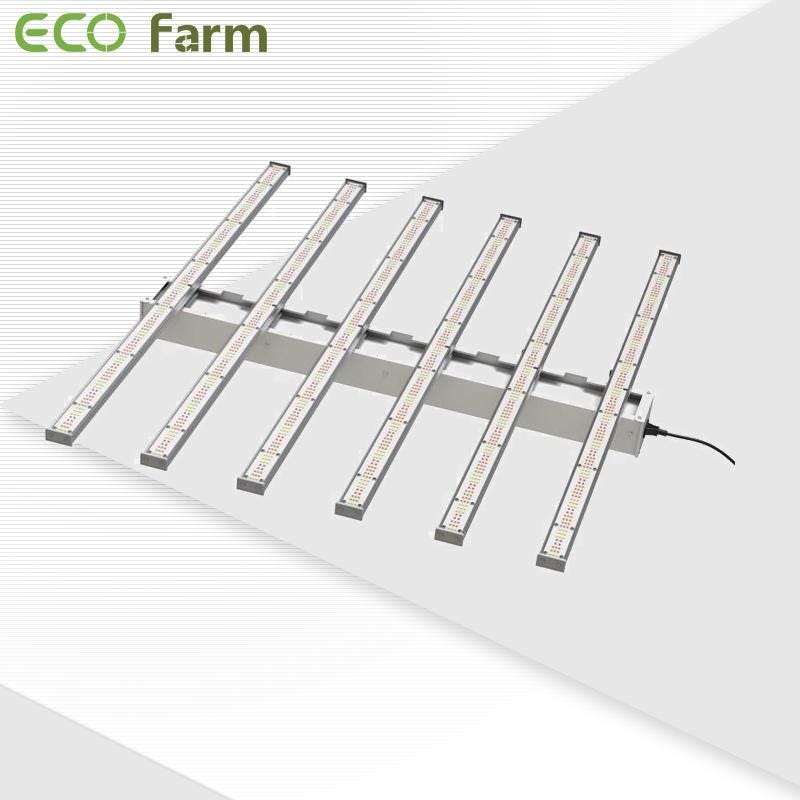
Features:
The ECO Farm grow light is equipped with Samsung full-spectrum white light + Osram 660nm plant red light and 6 high-efficiency aluminum rods to ensure high-efficiency PPE 2.5umol/J, better heat dissipation, and long service life. 6 LED growth lights, Each rod is covered with high-grade glue, waterproof, and easy to clean, not easy to be filled with dust. This plant growth light also uses a special dimmer, which can precisely adjust the brightness. 0–10 levels are optional. This means that you can see clear brightness levels and record while adjusting. No need to worry about differences. At the same time, it also has an ideal full-spectrum and amazing heat dissipation, close to natural sunlight. The spectrum applies to the entire stage of indoor planting. This lamp is equipped with the best radiator to get the best heat dissipation effect. Instant start, no flicker, long service life, and increase cannabis production. Finally, it is a fanless and zero-noise design, which is very quiet.
Phlizon 2021 Latest FD4000 Plant Led Grow Light 5x5ft Coverage
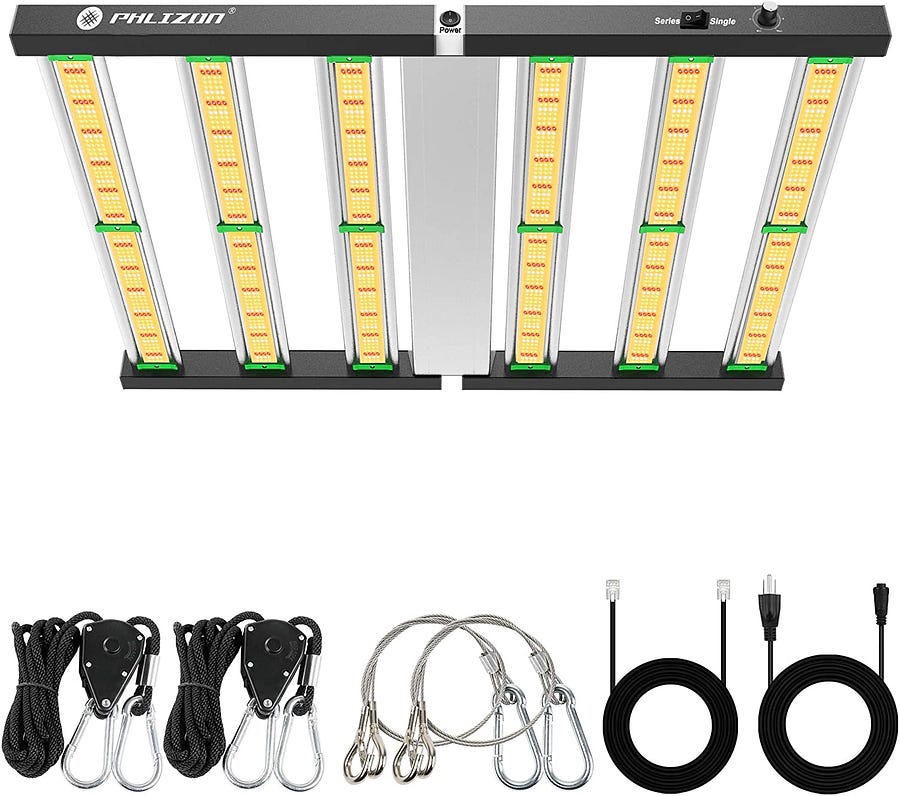
Features:
The FD4000 series grow lights use 1728 high-efficiency SMD LED lights, with market-leading efficiency, up to 2.9 μmol/J and 2.5 g output, an average PPFD of 30%, and actual power of 450 watts, which can cover 6 x 6 feet (approx. 1.8 x 1.8 meters) 1.5x1 5 feet for flower gardens. Adjustable light, full-spectrum, the light intensity can be adjusted according to the needs of plants. LEDs are all new technology SMD LED lights, including 1728 SMD LED beads, including 1056 3000K LED lights, 384 6000K LED lights, 264 660nm red LED lights, and 24 infrared LED lights. No fan and no noise, the lightbox is an all-aluminum radiator, low energy consumption FD4000 growth lamp, with 6 passive cooling rods, aluminum radiator, excellent heat dissipation, and service life performance, compared with HID lamps in the electricity bill reduced by 50%
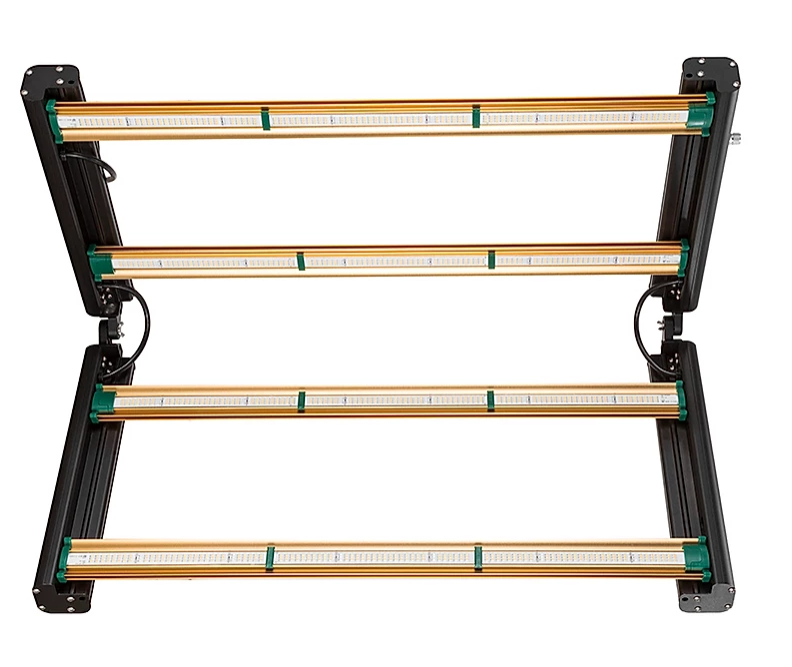
Features:
Utilizing Grower’s Choice proven 3K full PAR spectrum, this LED is perfect for professional cultivators and grow enthusiasts alike, who require a powerful LED fixture with a lower profile frame. This new, sleek LED is also perfect for hobby growers or entry-level professional cultivators who want to maximize their yields while working with limited space. The ROI-e420 is controllable with Grower’s Choice Master Controllers and is compatible with all quality master controllers. Cultivators can set the fixture to turn off and on at desired times, program sunrise/sunset settings, program dimming options and set protective fail-safes to dim or turn off the fixture in the event of excessive room temperatures, such as in the event of an HVAC failure, potential saving gardens from heat damage.
What to Consider When Choosing the Best LED Grow Lights
The following sections detail some of the most important qualities to keep in mind when shopping for the best LED grow lights for your needs.
Light Spectrum
Natural sunlight features all the colors on the electromagnetic spectrum. Some LED lights can reproduce only certain color frequencies, while full-spectrum white LED lights produce all the hues necessary for every stage of the growing process.
Blue light helps plants grow in the earliest stages of their lives. It’s the first color that plants can absorb in their vegetative state.
Purple light is also used in the vegetative state; however, it’s not as effective for photosynthesis as blue light.
Red light helps in the latter stages of growing and is essential for buds to flower.
White light encompasses all the colors of the spectrum. Used alone, it can be effective for every developmental stage.
Power
It’s a bit difficult to compare LED grow lights because manufacturers use a variety of metrics to measure the power of their lights and the amount of light they emit. The brightness of LED lights is measured in lumens. Seedlings require approximately 2,000 lumens per square foot to thrive, while flowering plants may need as much as 10,000 lumens.
While lumens measure visible light, biologists often use photosynthetic photon flux (PPF) or photosynthetic photon flux density (PPFD) to measure light intensity in terms of the light that plants will actually absorb. PPF is measured in μmol/second, which is the number of photons of light emitted every second. PPFD is measured in μmol/m2/s and measures the density of light distributed per square meter per second. The higher the PPF and PPFD, the more effective the light should be.
To establish how much electricity a light uses, look for its “actual power draw” or “actual power consumption.” This is measured in watts and gives a good indication of the light’s power. Bulb wattage is not a good indicator because LEDs are designed to be energy-efficient.
Heat Output
One of the risks when using a grow light is that the heat emitted by the bulbs can damage your plants. However, LED lights give off very little heat relative to the amount of light they produce. But they do produce some heat, so many models are equipped with built-in cooling systems to ensure proper temperature regulation.
Some LED lights have aluminum heat sinks, and others come equipped with fans. A unit with a fan might be loud, so factor noise level into your choice when selecting a grow light.
Connecting
Many LED grow lights are designed to link to other units to cover larger areas, which is typically referred to as “daisy chain connectivity.” Products with this capability simply plug into each other and then plug into one outlet, which minimizes the number of cords required for setup.
Conclusion
To help you settle for the best LED grow lights, we have compiled a list of the most reputable LED grow lights in the market from trusted manufacturers.
We believe that our expansive LED grow lights reviews post will help you make the right purchasing decision. You will not only get the best LED grow lights that meet your need, but you will also get value for money.
EYE HORTILUX Ascend LED 350-ES Grow Light VS AGLEX M320 LED Grow Light Bar for Indoor Plants
July 28, 2021
LED grow lights are becoming the go-to for hobby hydroponic gardeners and for good reason. LED grow lights are overall more efficient and have a longer lifespan. There are now so many different grow lights to choose from.
How Do Plants Use Light
Horticulture lighting is a science of spectroscopy that explores the interaction between plant biology and electromagnetic radiation. The sun propagates its energy through electromagnetic radiation which releases packets of energy called photons. Each photon carries a fixed amount of energy that causes the photon to vibrate or oscillate. The distance of one full cycle of the oscillation is referred to as its wavelength. The radiation spectrum of sunlight has wavelengths spanning from 200 nm to greater than 1000 nm. A very small part of this spectrum i.e. between the wavelengths 380 and 780 nm is capable of exciting the retina of the human eye and produces a visual sensation. This visible portion of the electromagnetic spectrum is called visible light. Coincidentally, this is almost the same range of wavelengths that plants react to (400 nm to 700 nm).
When the radiant energy of a single wavelength within the visible spectrum is viewed by the human eye, it appears to be of a single spectral color. In plants, the radiant energy of a single wavelength is utilized to drive photosynthesis, a photochemical reaction within the chloroplasts of plant cells. A chloroplast is an organelle that contains stacks of membrane-bound compartments called thylakoids. The surface layer (membrane) of the thylakoid is where chlorophyll, the key photosynthetic photoreceptor, resides.
Chlorophyll absorbs radiant energy from the violet-blue and reddish orange-red wavelengths of sunlight. The energy is used to drive electrons, which are split from water molecules through photolysis, to react with nicotinamide adenine dinucleotide phosphate (NADP). The reaction changes this carrier molecule from its oxidized state (NADP+) to its reduced state (NADPH). Photolysis of water also produces oxygen as a byproduct and hydrogen ions (protons) which form a proton gradient (energy gradient). The proton gradient drives the generation of adenosine triphosphate (ATP) through the action of ATP synthase that is present in the thylakoid membrane.
Photosynthesis proceeds in two phases: light-dependent reactions (light reactions) and light-independent reactions (dark reactions). Products of the light reactions, ATP and NADPH, are used to reduce carbon dioxide and convert it into glucose. Glucose is the energy source used by plants for cellular activities such as protein synthesis or cell division, it can also be passed into other biosynthetic pathways to form DNA. Complex carbohydrates formed by linked glucose molecules can be used to store energy for future needs (starch) or to build the cell wall of plant cells (cellulose). The series of reactions of using ATP and NADPH to produce glucose from carbon dioxide does not involve the use of light, and thus these reactions are called the dark reactions (also known as the Calvin cycle, named after Melvin Calvin who elucidated the pathway).
Plants also use light as a source of information to drive photomorphogenesis and photoperiodism. Photomorphogenesis refers to a developmental adaptation mechanism employed by plants to regulate seed germination, seedling development, organ orientation, cotyledon expansion, stem elongation, stomatal opening, root growth, and other morphological changes. Photoperiodism is a rhythmic characteristic of biological processes developed by plants in response to the variations in day length and dark period. Photoperiodic control is commonly used in horticultural applications to steer plants from vegetative to reproductive growth for induction of early or out-of-season flowering.
EYE HORTILUX Ascend LED 350-ES Grow Light

Features:
Eye Hortilux LED extends the standard LED growing spectrum providing energy outside the PAR range to include ultraviolet (UV) and far-red, promoting stronger plant growth with heavier flowers. The LED 350-ES is for growers with limited space who need lower wattage. This three-bar system will cover a 3×4 space with the same spectrum and benefits as the LED 700-ES. This unit is perfect for the small hobby grower looking to get the highest quality garden in smaller spaces. This LED plant grow light provides a full-spectrum light source of natural light from 380 nm to 780 nm (including UV + IR). This means providing synthetic sunlight for your indoor garden because it provides light covering the entire natural spectrum. For you, this means plants grow faster, yield greater and higher yields at harvest. Unlike traditional high-pressure sodium (HPS) bulbs, this LED grow light uses high-tech LED chips to get more light with less electricity.
AGLEX M320 LED Grow Light Bar for Indoor Plants

Features:
The AGLEX LED grow light is equipped with an upgraded SMD 3030 chip and 6 high-efficiency aluminum rods to ensure high-efficiency PPE 2.8umol/J, better heat dissipation, and longer service life. Compared with old plant lights, the output per watt can reach up to 2.8 grams, the average PPFD is increased by 30%, and the yield and quality are increased by 50%. It consumes only 320 watts, 672 LED lights, and covers an area of 5 x 6 feet. The 320 watts LED grow light M320 will help you achieve maximum quality and quantity. You can freely control and adjust the light intensity outside the planting tent, without having to go in. It is easy to operate in your hand. It is composed of full-spectrum white 3000K 5000K, red 660 nanometers, and infrared 740 nanometers, which are close to natural sunlight. The spectrum applies to the entire stage of indoor planting. The full-spectrum LED grow light is equipped with 6 high-efficiency aluminum bars.
What are the light requirements of plants?
We all know that plants need light, right? In kindergarten, we all put our seed in a dixie cup and place it on the windowsill. Add the other magical ingredient — water — and up comes the sprout, always moving towards the light.
Plants seem to instinctively “know” that without sunlight their growth will be stunted.
You can’t just use any light you find, however.
We’ve already covered some of the differences in the lighting options available to indoor gardeners, but how do we know which is better? First, we need to know what makes light helpful to a plant in the first place. There are three factors that have a substantial impact on how the light a plant receives will affect its growth. These factors are:
Light Quantity — Historically, light quality has been expressed in units called lumens. While useful to scientific research on light affecting human sight, the term did not accurately account for measuring the photon particles of light coming into contact with a plant. Botanists and horticulturists now prefer to use Photosynthetic Photon Flux Density (PPFD); an explicit measurement used to calculate the number of photons hitting a given surface — per sq. meter, per second.
A second term of value to plant science is the Daily Light Integral, which is simply a measurement that includes the photon density (PPFD) and the number of hours that a plant spends exposed to that rate of photon contact. Generally speaking, more light is required for flowering than for vegetative growth.
Light Quality — As I mentioned earlier, not just any ‘ol light will do. We need special kinds of lights to grow plants. Why? When we talk about the quality of light, particularly as plants determine it, we are really referring to spectrum — or color. All plants have photoreceptors that are triggered by photons of their respective spectrum entering the plant’s system. When taking light quality under consideration in your own project, ensure that your lights are either full-spectrum or that you have separate lamps to account for the spectrum of light needed at the different stages of growth.
Photoperiod (Light Duration) — The photoperiod is simply the amount of time the plants spend in the light or the dark. It can get a bit more complicated than that, however, as these light/dark cycles can be controlled to manipulate the growth of indoor gardens. A popular example is found in applying large doses of light for 18–20 hours/day throughout the vegetative stage, then cutting the light down to ~12 hours or so to trigger the flowering stage. This is known as photoperiodism and is used to optimize growth and yields.
Why ECO Farm LED Grow Lights are Better for Plant Growth
Plants need a full spectrum for proper growth. They get this naturally through sunlight, which is a blend of all the colors of the rainbow. When it comes to LED lights, the spectrum colors are referred to as wavelengths in order to be more specific. Because there are many hues of red, for instance, simply say “red” doesn’t cover the entire range of red tones. Plants need wavelengths in both the blue and red spectrum, which drives photosynthesis. However, they also need other colors for various processes. That is why full-spectrum grow lights provide the best light for plants. When you use ECO Farm LED grow lights indoors as greenhouse grow lights, hydroponic grow lights, or simply for your favorite houseplants, you don’t get that horrible off-color from other LED lights. That is because they have a superior color rendering index (CRI) as compared to other manufacturers. The resulting light is natural and not tinged purple, which can make it difficult to observe plant health. The full spectrum grow lights from ECO Farm also provide all the wavelengths in the color spectrum for better plant growth. The resulting light resembles actual sunlight, which is the optimum light for plants.
Conclusion
We hope this resource helped you to decide which LED grow light is right for your indoor garden. When all the information is in one place, the advantages become pretty obvious. We don’t want anybody to make their decision based on outdated information, or stick with yesterday’s technology simply because they don’t understand the new stuff.
Indoor gardening began as a hobbyist pursuit, with little commercial application. Today, indoor agriculture is a standalone industry. Largely in part due to advances in LED lighting technology, commercial growers are harvesting more per plant than ever before.
Best 630W LED Grow Lights For Your Indoor Plants
July 27, 2021
If you want to start your veggie garden like a pro, you need the best grow light. A grow light imitates the rays of the sun in a specific spectrum, providing your seedlings with the optimal light spectrum they need for speedy growth.
With growing zones expected to shift on the coming Grand Solar Minimum, a seedling grow light can help you get an early start on the growing season. As a result, you get more harvests per year, increasing your food stockpile.
What Are LED Grow Lights?
Light-emitting diode (LED) grow lights are some of the best on the market. They provide a high light output across the full spectrum, including visible, ultraviolet, and infrared wavelengths. Recent developments in technology have seen LED’s become more affordable and effective, making them perfect for an indoor garden.
We absolutely love LED grow lights. Despite higher upfront costs, LED’s are far more efficient than other types of grow lights, saving on power and electricity costs — some run for as little as 30 cents per day.
Because of the full spectrum of light produced by LEDs, they yield exceptional results in both vegetative and flower cycles. The normal life-cycle of an LED bulb is about 50,000 hours, five times that of a fluorescent bulb, so you’ll get years of use without any need for replacements or upgrades.
Grow Tents
Utilizing a grow tent can help take your indoor setup to the next level. They maximize output efficiency by preventing light from escaping, helping you to achieve maximum yields. Our picks for the best led grow lights fit perfectly into grow tents, thanks to their rectangular design. If you’re serious about getting great results from your indoor garden you should consider investing in a grow tent as well.
Best 630W Led Grow Lights Recommend For You
ECO Farm 630W Samsung LM301H /LM301B Full Spectrum Folding LED Grow Light

Features:
The ECO Farm grow light is equipped with Samsung LM301H and Samsung LM301B chips. High-PPFD >1200µmol/m²/s @0.15m, high efficiency, PPF efficiency up to 2.8umol/J, better heat dissipation, and long service life. Compared with old plant lights, the average PPFD is increased by 30%, and the yield and quality are increased by 50%. Specially designed for growers, challenge the limit through high PPFD cultivation practice. 6 LED growth lights, each rod is covered with high-grade glue, waterproof and easy to clean, not easy to be filled with dust. This plant growth light also uses a special dimmer, which can precisely adjust the brightness. At the same time, it also has an ideal full-spectrum and amazing heat dissipation. Use SOSEN or Meanwell power supply, longer life and more reliable. Suggested installation height: 6" ~ 12" (15~30cm) above plant canopy
Omega Luna 630w Led Grow Light

Features:
The new foldable Omega Luna LED 630W Grow Light has run super cool in operation and with a life span of around 50,000 hours or more, your plants are in for a real treat as they receive a full spectrum LED suitable for the full growth cycle at a photon efficacy of 2.6 µmol/J. Consuming only 630 watts of power the Omega LUNA 630W Grow Light uses the professional LED Chips from Samsung 2835 & Osram red Diodes and is fully dimmable to 250, 380, 500 & 630 watts. Providing the same amount of light as an HPS lighting — but consuming less energy and giving off less heat, heat management will be much easier to manage. Specifically designed to provide uniform levels of PPFD across your plant canopy, therefore you can expect more yield at harvest as the full spectrum is emitted across the plant canopy and is not wasted on grow room walls.
Loriflux 630W Full Spectrum LED Grow Light
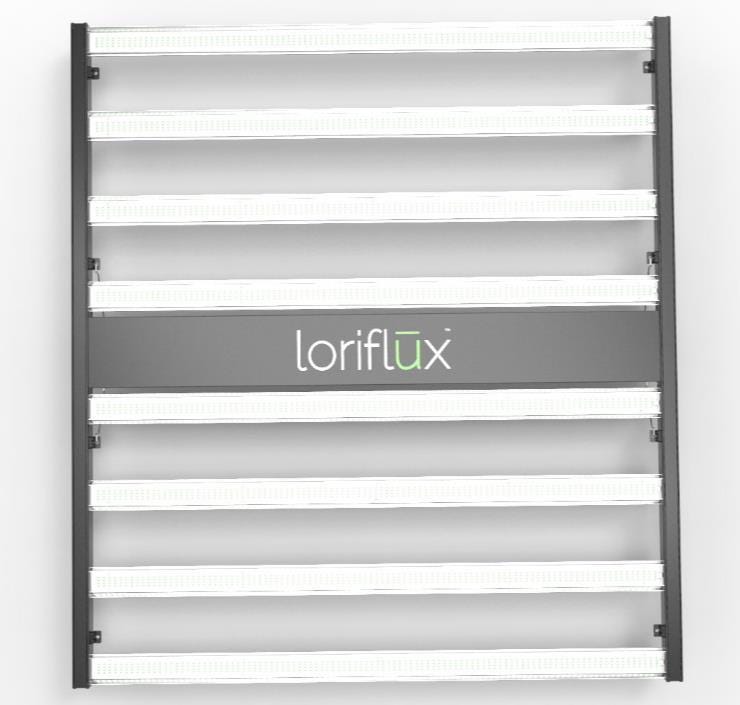
Features:
This fixture was designed and engineered by growers for use in full-cycle cultivation. With variable power levels and a rigorously developed and field-tested spectrum, our light vastly simplifies the growing process while allowing even the most seasoned veterans the control and power to exceed yields beyond anything they have ever experienced. For optimal results, we recommend that this fixture is used in environments with supplemental CO2 at a range of 800–1400PPM due to the high concentration of PPFD. Constructed from aircraft-grade aluminum and top brand LEDs and Drivers, the low profile, durable and sleek design of our fixtures allows our product to be utilized in ANY growing environment whether it be large scale commercial, vertical, or hobbyist
Grow Lights Buyer’s Guide
Plants require air, water, and light to grow. When the winter pulls around, the days get shorter, and the sun’s rays lose intensity. As a result, it’s challenging to grow plants until the ground thaws in the spring.
If you live in the Northern Hemisphere, that means you can only put plants in your vegetable garden or flowerbeds when it’s mid-spring. Unfortunately, the shorter seasons in the Northern Hemisphere mean you don’t get a longer growing season than you do in the south.
If you want to get more out of your garden this year, you’re going to need to start your plants indoors. To achieve growth indoors, you need an indoor grow lamp to provide your plants with the chance to produce food to thrive.
It’s easy to reproduce the effects of rain and air. However, lighting presents the biggest challenge to replicate indoors. Leaving your plants on the windowsill won’t work — you need an indoor grow light for your seedlings.
Why Do I Need a Grow Light for My Seedlings?
An indoor grow light for your plants mimics the sun’s rays, providing you with a source of light energy for your seedlings. Your seedlings can’t tell the difference between the grow light and the sun, as the grow light emits the same lightwaves.
Therefore, you can start your plants four to six weeks early, transplanting them into the garden as the ground thaws and spring starts. This strategy gives you a longer growing season and an additional harvest.
Indoor grow lights allow you to start early, and your plants should be ready for transplanting as soon as the spring gets into swing.
Features to Look for
When purchasing the best grow light for seedlings, we recommend looking for the following features in a prospective model.
LED Lights
All modern grow lights feature design with LED technology. LED is effective and affordable to run. It’s the best way to give your plants the optimal spectrum they need for growth. LEDs have a longer service life than fluorescent, incandescent, or metal halide bulbs, and they use less electricity.
LED Output and Power
When selecting your ideal indoor grow light, we recommend looking at the LEDs’ output in your prospective light. The average small grow light for seedlings needs between 45-Watts to 80-Watts of light output. That’s enough lumens to help your plants achieve optimal growth.
LED Quality
The quality of the LEDs in your grow light makes an enormous difference in service life. The average high-quality T5 LED should provide you with at least 10,000-hours of service life before replacement.
Light Spectrum
It’s critical that you look at the wavelength emitted by the device when purchasing your grow light. Plants require full-spectrum light for the best growing results. Look for models featuring a full PAR spectrum, offering both red and blue wavelengths. Some models will also feature white light.
Lighting Modes
Your LED grow light should feature different lighting modes. Look for models offering blue, red, and full-spectrum modes for your choice of growing conditions. The lighting modes affect your plants and how they grow.
PAR refers to the balance of red, blue, and white light in your LEDs. Top models feature high PAR ratings, giving you the best performance out of your new grow light.
Timers
The best grow light for seedlings comes with timers. You get the option of setting your light cycle to 3-hours, 6-hours, or 12-hours, depending on your plant’s needs.
A timer is a handy feature in your light, allowing you to control the light cycle. However, if your model doesn’t come with a timer, you’ll have to purchase one separately or rely on manual operation.
Reflectors
A reflector helps increase the light intensity from the LEDs, amplifying the light output. Some reflectors can increase lumen count by up to 30%, depending on the design and materials used in the reflector. The best reflectors feature design and construction with polished aluminum or mylar materials.
A reflector is not an essential piece of equipment for your grow light. However, we recommend looking at models with reflectors to speed up your seedling growth. Some models come with detachable hoods, while others have permanent fixtures.
Propagator Hoods
If you’re starting cuttings, then you need a humid environment to help with the rooting process. A propagator is a type of lighting setup involving a seedling tray and a clear hood, with an LED light on top.
This setup allows you to contain humidity and heat inside the growing area. As a result, your plants root faster. Propagation kits are also good choices for growing seedlings. The additional moisture and warmth accelerate growth.
Adjustable Light Height
As your plants are growing, you need to move the light up to keep it at the correct distance from the canopy.
If you place the light too close to the plants, it results in the burning of foliage and delayed growth. Some models come with gooseneck arms for easy adjustment, while others have hanging cables or telescopic legs for fast adjustment of the light height.
Conclusion
There are heaps of great options out there for LED grow lights in 2021. Whichever you chose, make sure you do your research and know exactly what you are looking for. The key to yielding the best results in finding the perfect grow light for your individual setup.
